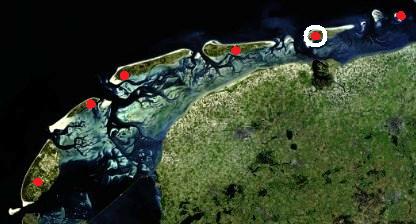
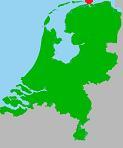
Relation with Lake (class): none. Cemetery without lake link.
Total nr. of graves here (TC): 112 today (90 WW2). 9 French exhumed 1949.
Lake casualties, initially, end WW2 (LC-I): 0
Unknown today: 17 Commonwealth servicemen, WW2. Unknown French: 14
of which unknown from Lake (LC-U): 0
of which unknown from North Sea (NS-U): all.
Initial burial site in WW2: yes.
Post war burial site for collection and reburial from other sites: no.
Cemetery with Lake casualties today: no
SCHIERMONNIKOOG 'VREDENHOF' CEMETERY
Unique island cemetery, hidden in the dunes. Probably the most beautiful (war) cemetery in the Netherlands. Only for washed ashore 'victims of the sea'.
First grave dates year 1906, last 1968. Hundreds of sailors washed ashore on this island since medieval times. Originally they were buried without much formality at the foot of the dunes, often too close to the sea, which exposed the bodies again after a storm. From 1863 onwards, burials were made higher up the dunes along the road to the lifeboat station. In 1917, under pressure of a growing number of washed ashore WWI sailors, local townsmen among them hotel keeper Mr. Sake van der Werff took initiative to give the burial location a more permanent and dignified status. With help of the owner of the island at that time, German count Ernst August von Bernstorff (all his islanders were and are Dutch) a small cemetery was set up, Vredehof. It grew considerably in size during WW2. In this article the build-up of the cemetery is explained.

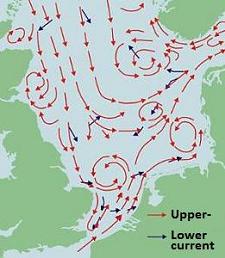
Dutch name cemetery: Vredenhof.
CWGC name: Schiermonnikoog (Vredenhof) Cemetery
Address: Reddingsweg. Near German Wassermann radar bunker.
No vehicles are allowed on the island.
There is a bus-service from ferry-pier to village v.v.
Car park is at ferry station on the mainland
Address: Zeedijk 9, Lauwersoog.
Ferry-frequency is 5 times per day.
For reaction or comments; send us an email,
see address and info at CONTACT.
Please use as subject title: 'Vredenhof'.
Up to today the cemetery is privately owned by the Vredenhof Foundation, in which Hotel van der Werff owner Jan Fischer (deceased), cemetery caretaker Wyb-Jan Groendijk and the German count Bernstorff family are leading. Mr. Jan Fischer lead the hotel for 32 years and died on 30 August 2014 (74). He is buried in his Vredenhof Cemetery next to initiator Mr. Sake van der Werff (see photos further below). Unique for this cemetery is that all nationalities were buried next to each other in washing ashore sequence and still rest here today, friends next to enemies. All graves are uniform and have a frame filled with sea shells and a typical low small headstone that is tilted back in a 45° angle. Only the inscription-language on the headstone varies: "Ein Deutscher Soldat", "Mort pour La France", "An RAF Airman of the 1939-1945 war, Known unto God", etc.
After WW2 the fighting nations centralized their war dead. Then caretaker of this cemetery, Mr. Sake van der Werff withstood the pressure and could accomplish that the casualties from the UK, Canada, New Zealand, Australia, Poland, Germany and France were not exhumed and not moved to elsewhere. They could stay in their initial resting place. Only 9 identified French soldiers & sailors (1940 washed ashore Dunkirk victims) were exhumed in 1949 and repatriated to their family in France. The other 21 Frenchmen stayed at rest here. This site is the only one in the Netherlands outside French centralization cemetery Kapelle (NL) were French soldiers are buried.
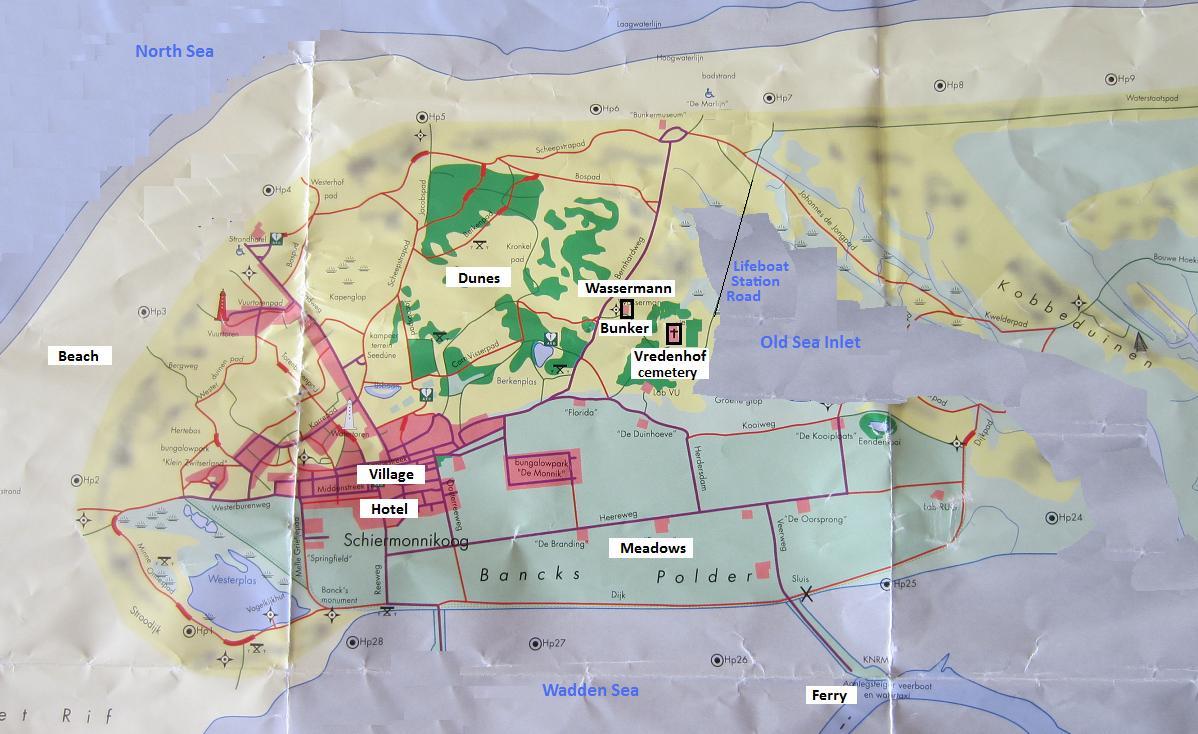
---------------
1906, 1917 and 1922 first photo.
On 9 July 1906 an unknown British fisherman washed ashore, he was 65 years old. He was buried on a dune, one boot on his feet. In 1917, the space around his grave became the cemetery and his grave got grave number 1. In the first World War the cemetery grow with 12 graves, all washed ashore navy sailors: 11 German and one unknown British. Postcard below shows the situation in 1922, one of the first photographs of this cemetery. The perimeter is fenced off with chicken wire. White stone cross in the back reads 'Oorlog 1914-1918'. Cemetery gate is a steel rod fence with name 'Vredehof'. Tool shed/morgue behind the cross is not build yet. 'Vredehof' (Yard of Peace) is a Dutch translation of the German word 'Friedhof'.
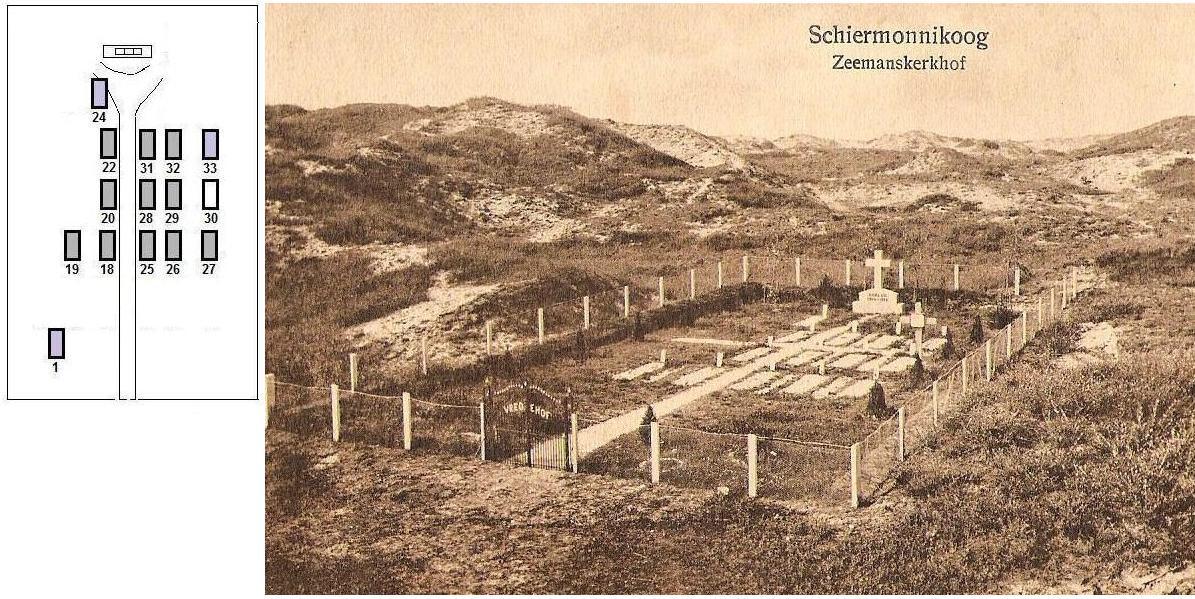
Grave list 1906 - 1922
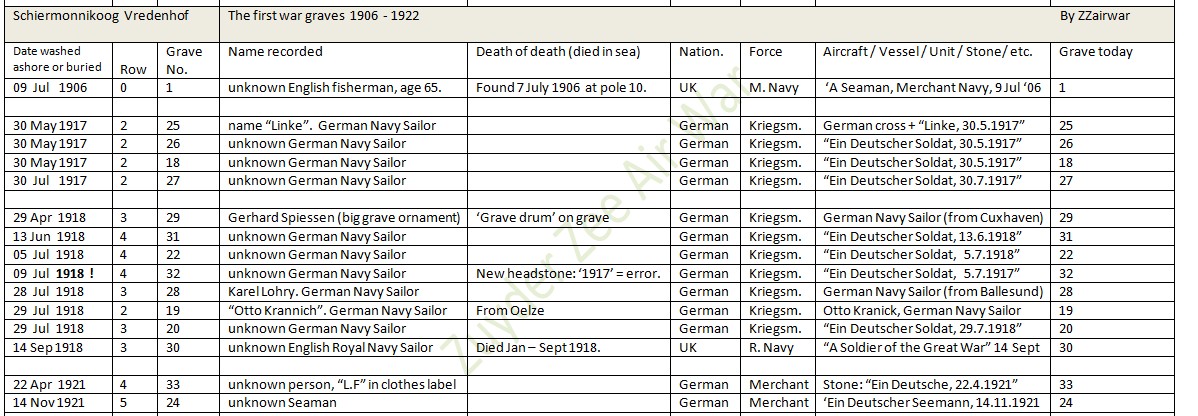
1917. The first four WW1 casualties buried here: four German Navy sailors. Battle of Dover Strait, 20/21 April 1917.
Based on North Sea current-pattern and time elapse, the group of first four buried 1917 German sailors cannot be casualties of the Battle of Jutland, as often is said. This sea-battle was too far north, down-stream and a full year before these four German sailors washed ashore here. We believe these German sailors are casualties of the German Torpedo boats SMS G.42 and SMS G.85, sunk in battle with HMS Broke and HMS Swift near Dover/south-east Ramsgate on 20/21 April 1917, see map below. The bodies followed the same route to this island as the later Dunkirk victims in 1940. SMS stands for 'Seine Majestät schiff' (HMS). These G-class destroyers were type 'Großes Torpedoboot 1913' and build on the Germaniawerft (G) in Kiel. In this battle the German Kaiserliche Marine lost 69 men. Read more on this clash here: http://www.lookandlearn.com/blog/12596/commander-evans-and-the-battle-of-dover-strait/
Chart of the 20/21 April 1917 sea-battle.
German ships in two 'half-flotilla' broke through the British blockade at 7a and 13a and turned to Dover. British destroyers HMS Broke and Swift at 3a stopped them.
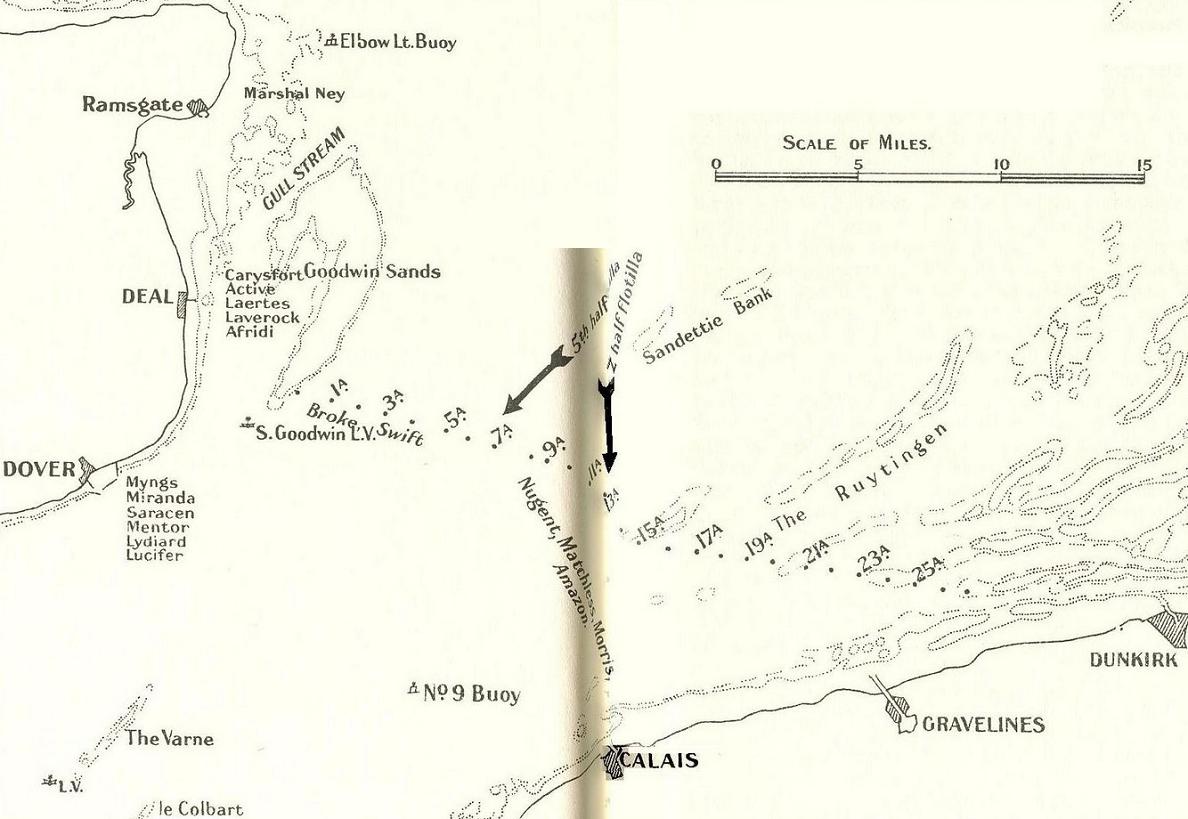
Mine sweeping 20 April 1918.
The German ports on the North Sea (German Bight) were blocked by the Allies with huge minefields. On 20 April 1918, a convoy of four German Torpedo boats, assisted by a number of small M-class minesweepers of the 8th Minensuch Halbflottille, tried to work their way through the minefields. They were heading west towards Zeebrugge and Oostende (Belgium coast). In the shipping-lane above the Dutch Frisian Islands, on position 33km north of Terschelling, the German minesweeper M.64 (Minensuchboot) was hit by mine-explosions. Also the M.95 and the M.39 were hit when they came to the rescue. The other ships stopped and rescued 60 men, but 100 sailors were missing, 7 washed ashore here.
In the above table, German Sailor Gerhard Spiessen was crew of M.39. Captain was Oblt. z. See Otto Ivens. The father and mother of Gerard Spiessen visited the grave of their son on this cemetery in 1920 and showed photos of him and his ship (see below). Also the other German sailors are very probably casualties of M.39, M.64 and M.95. On next Frisian isle Ameland also washed ashore on 3 July 1918 a crew member of M.64, this was Paul Otto Muller. He was exhumed and reburied in the German centralization cemetery in Ysselsteyn in the Netherlands, but Gerhard Spiessen and his friend Otto Kranick still rest at Vredenhof. Photo below: their Minensuchboot M.39.

1921. Two unknown civilian sailors.
In April and November 1921, two unknown merchant sailors were buried in grave 33 and 21, near the cross. One of them had "L.F." in his clothes. Both were German.
VREDEHOF 1925
In year 1925 the tool shed was build. No further change except that the family of German sailor Gerhard Spiessen placed a large grave monument and a so called 'grave drum' on his grave (grave 29). Below image is a postcard from that period, sold then to tourists on the island.
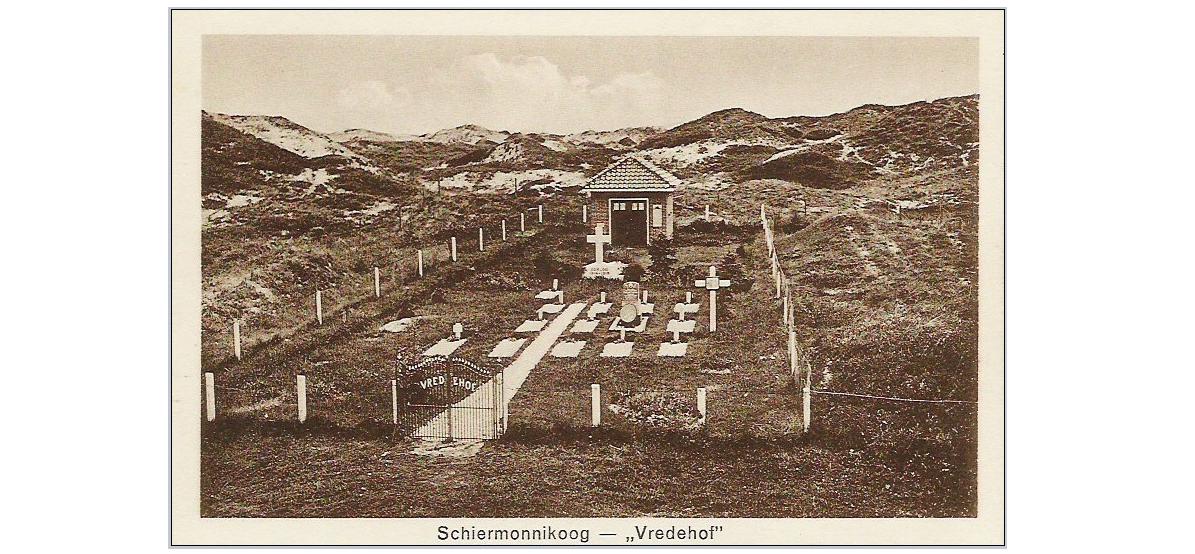
1934.
A new grave was added approx. 1930. On below postcard from year 1934, this grave is visible most left in grave 21. This German navy sailor washed ashore 5 July 1917 and was initialy buried elswhere on the island. Many years later when new headstones were made and positioned, the stone intented for him with 05.07.1917 was incorrectly placed on another grave (grave 32), also an unknown German navy sailor, but buried in 1918. The man died in 1917 in grave 21 got the 1918 dated stone. Photo below: a man studies Gerhard Spiessens monument and grave drum. Two boys are standing at the 1914-1918 cross. The 1930 burial brought the number of WW1 victims on 13 (12 German sailor and one British).

.
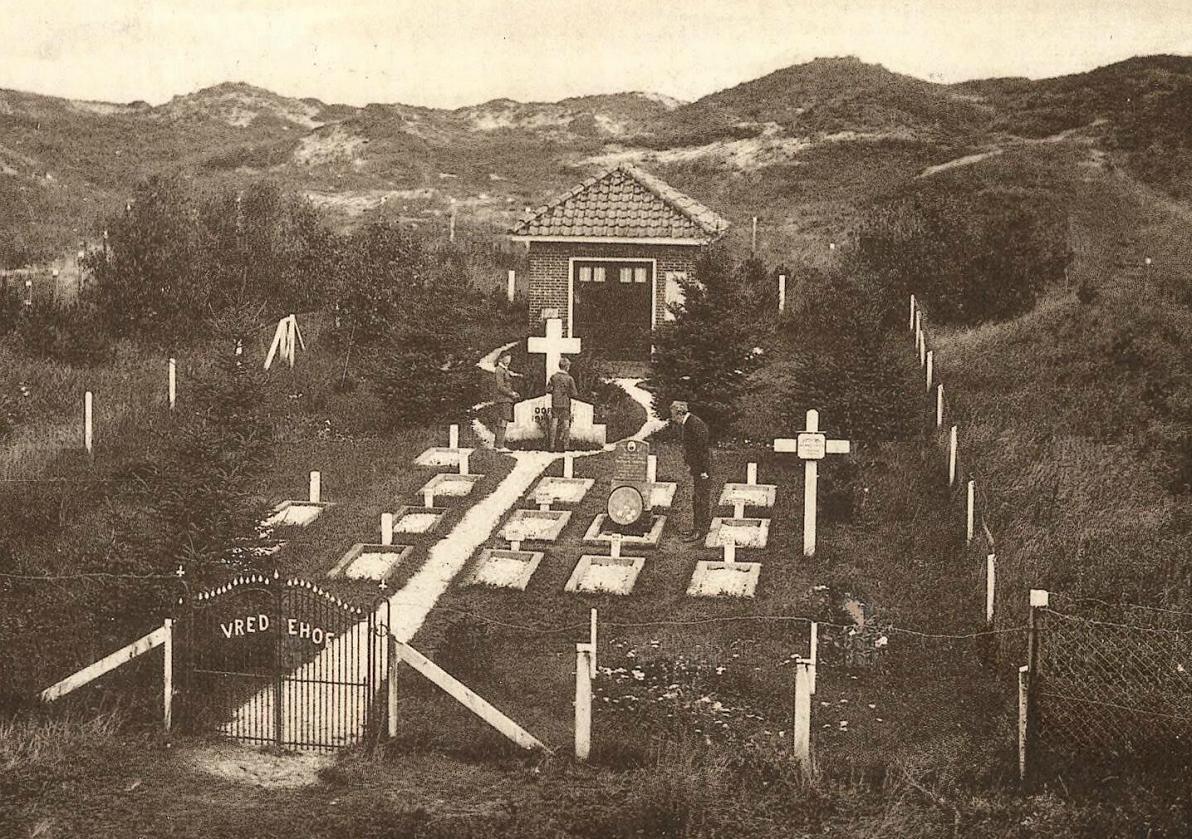
1936
Postcard below. In 1936 the name of the cemetery changed to 'Vredenhof'. The steel gate was replaced by a wooden gate with 'rising sun' (or setting sun) motif and the new name. This is how the entrance would look for the next 10 years and during WW2.
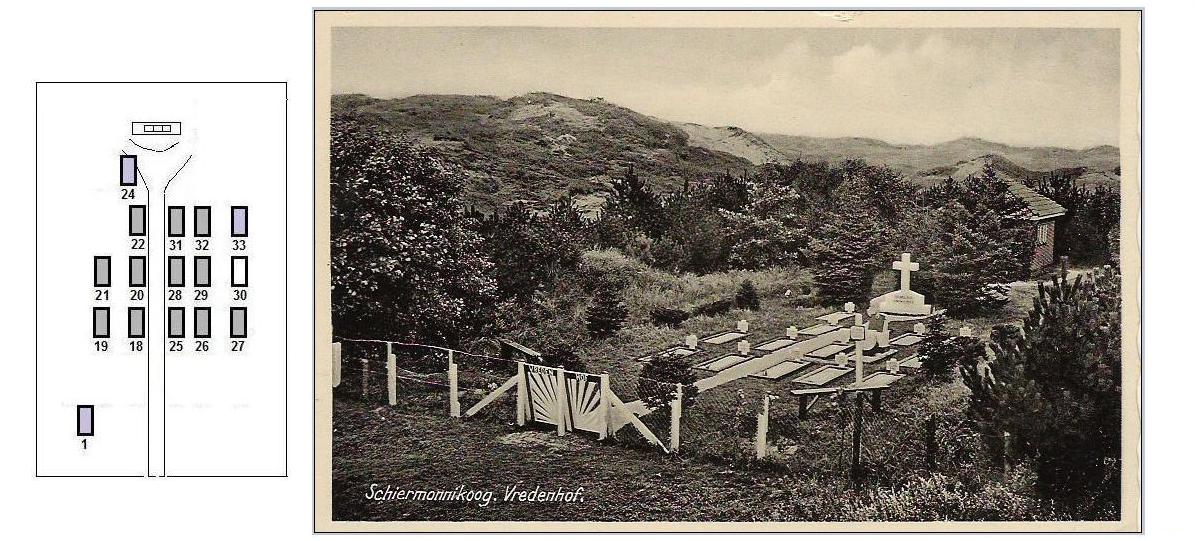
1938 until June 1940. And the start of WW2.
1938, the Headless Giant. In July 1938 a man washed ashore, buried grave 23 (see below photo & map). Local folklore says this man was very tall. He measured 2,0 meter from shoulders to feet. If his head would have been present, his length would have been 2,30 meter. His head was cut off clean with a strait cut, as done by a very sharp blade. Furthermore he wore oilskin gear and yellow boots with climbing-irons/spikes. On this grave marker came: "A German Seaman, 23 July 1938".
WORLD WAR 2.
The first three casulaties, British RAF airmen.
In Sept. 1939 WW2 broke out. Two months later the first (of many) English airman washed ashore; Aircraftman 1 (AC1) Alan Wilson, crew of Hampden L4127 of 144 Sqn. Holland had not entered the war yet (10 May 1940) and Wilson was buried by the Dutch in presence of the British military attaché. The Germans occupied this island 16 May 1940. From then all burials were made under their control and often with military honour. In June 1940 they buried two crew of RAF Blenheim L9259 of 626 Sqn; Sgt. William Martin and P/O Micheal E. Ryan. The Germans buried them left and right of Alan Wilson, see war-time photo of their crosses further below (grave 17,16 and 15).
Plot 2 (behind the tool shed) build 1939/1940.
The leading man behind the cemetery, Mr. Sake van der Werff, decided in 1939 to extend the cemetery with a new 2nd plot behind the tool shed. A remarkable decision, since WW2 had not started yet and there was plenty of free space available on plot 1. As a former police constable and since 1913 hotel owner with a lot of international (read German) guests, he must have developed a clear and foreseeing view of the dark years to come... Under: virgin plot 2 in development. The connecting path to plot 1 behind the men is not made yet.
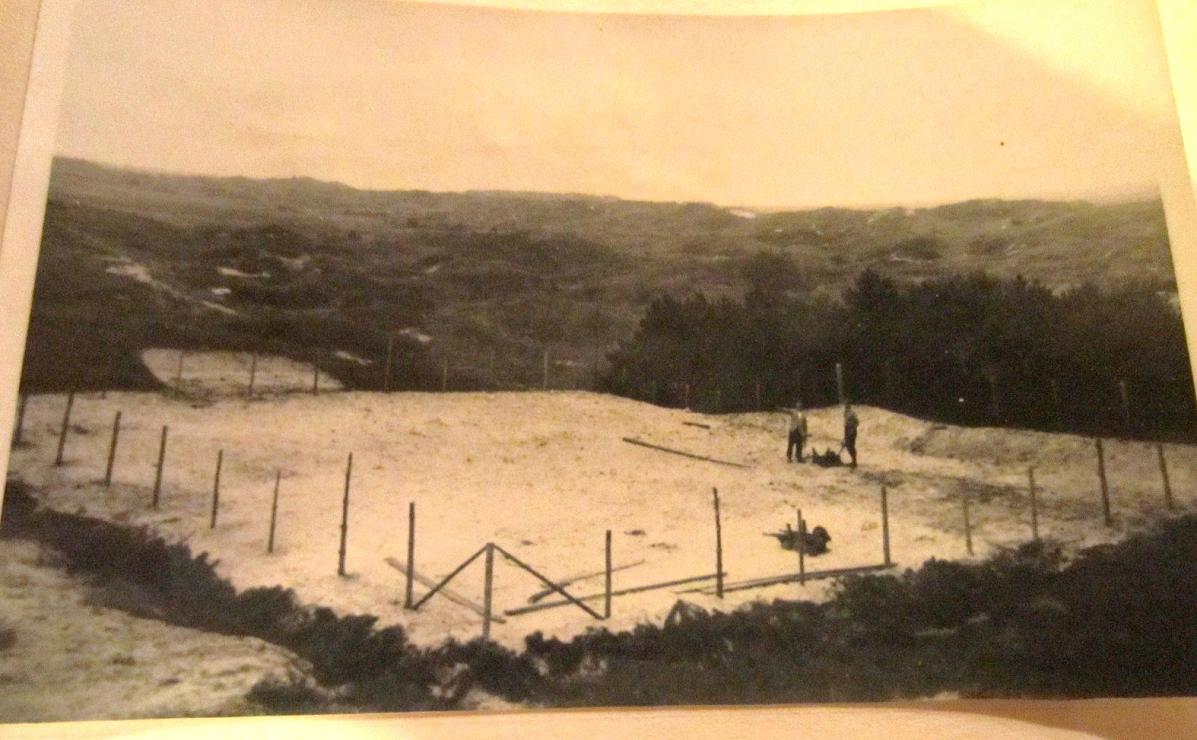
1938 - June 1940
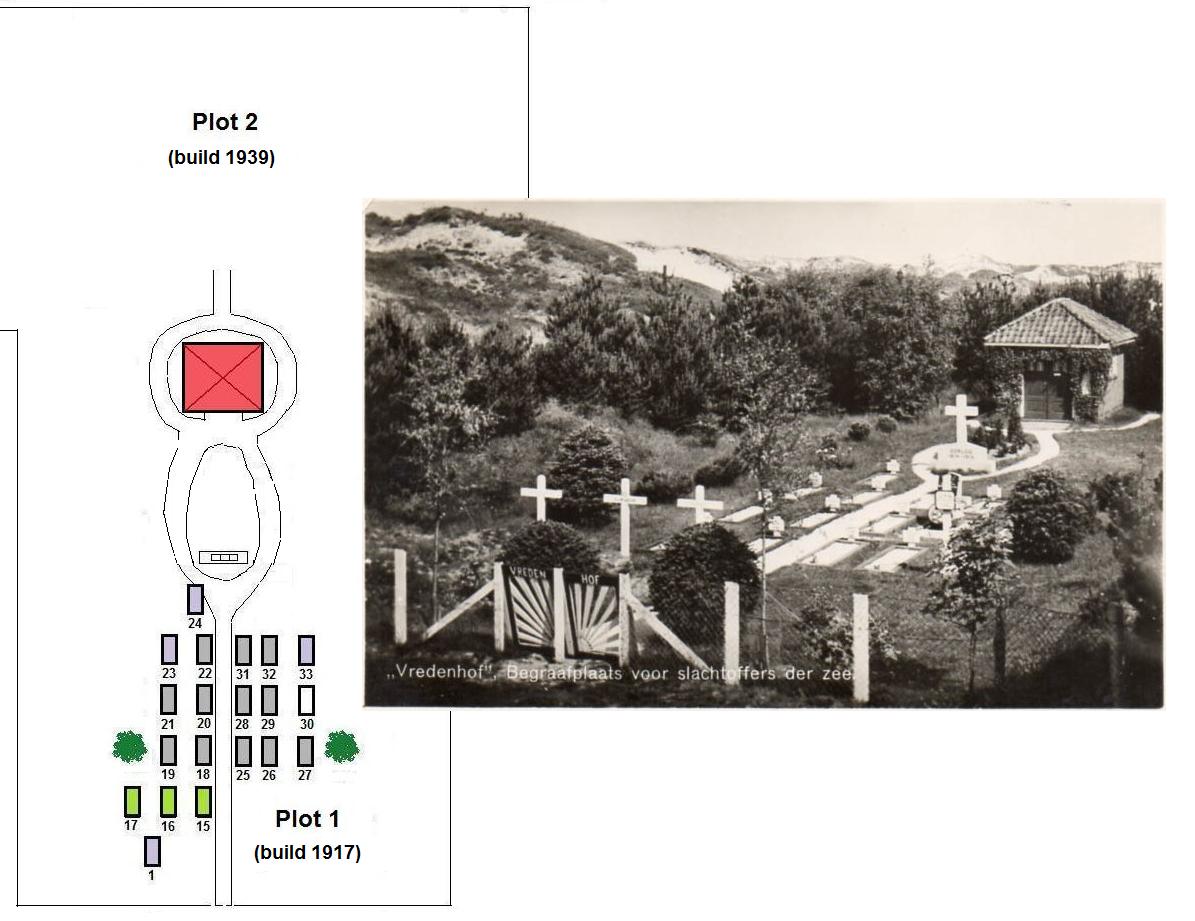
Burials 1938 until June 1940.

.
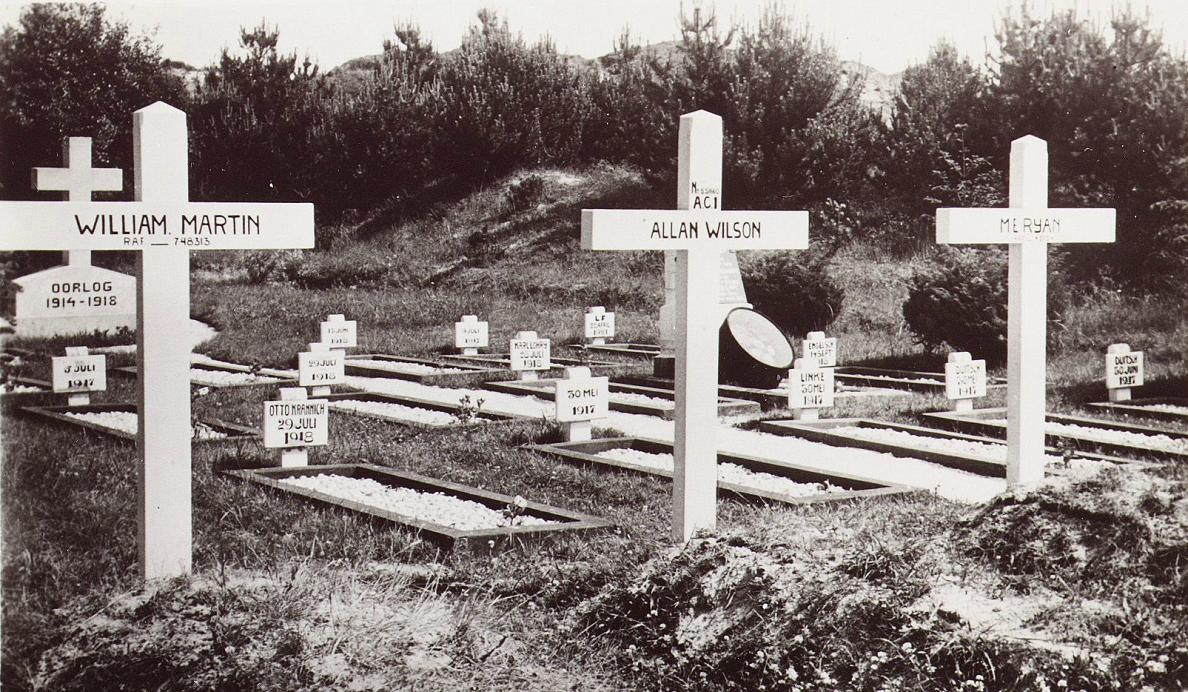
Above. Crosses of the first three WW2 casualties buried on this cemetery.
First was buried AC1 (Aircraftman 1st class) Alan Wilson, shot down 29 October 1939 (Hampden L4127) washed ashore (photos exist) and buried 29 November 1939 by Dutch and British officials. This island was occupied by the Germans 16 May 1940. They buried the next two washed ashore British airmen (1 and 15 June 1940) left and right of Alan Wilson. Left Sgt. William Martin, right his pilot Micheal E. Ryan. They were crew of Blenheim L9259, North Sea north of this island May 24, 1940.
The above photo shows the still fresh graves of the three RAF airmen; crosses with heaps of sand in front, this in contrast of the 1914-1918 graves. The photo shows details mentioned earlier in this article: left the in 1930 added 5 July 1917 German sailor, German Sailor (minesweeper incident) Otto Kranich from Oelze, Karel Lohry, Gerhard Spiessen's grave drum, civilian sailor "L.F" in the right upper corner, the only British WW1 casualty "English 14 September 1918" (right side) and the unknown German sailor 'Linke' washed ashore 30 May 1917.
DUNKIRK. OPERATION DYNAMO. MAY 26 UNTIL JUNE 3, 1940. THE EFFECTS HERE (425 KM FURTHER) END JULY, 1940.
Dutch newspapers report that on Sunday 28 July 1940, four French soldiers, one of them an officer (Marquézy) washed ashore here and were buried on the 30th July 1940. A day later again 17 soldiers washed ashore, found by three young man that were swimming. One bumbed into a floating corps. The men laid the body on a plank that the sea had delivered on the beach (driftwood). When they looked closer, they noticed more bodies in the water and recovered them all. Spread out on the beach and based on the uniforms, it could be made out that 14 of them were French, 3 were British.
The three young Dutchmen (21 years old) were mailman Tjalle de Jong, village carpenter Leo van Veen and dyke-worker Nico Faber. The local doctor, the mayor and German island-commandant Kapt.-Lt. zur See Arnold Rehm (died 1976 in Bremen) searched the bodies. They ordered Leo van Veen to build 17 coffins and Nico Faber to dig 17 graves on Vredenhof because the till then sleeping cemetery had no personnel. Nico held this job for the rest of the war. All regular coffins on the treeless island were used up in the burial of the first 4 French. Therefore Leo van Veen used driftwood to make new coffins. After sanding the planks, they looked decent and suitable. Natural planks were kept together to make a natural coloured coffin, darker wood for darker ones. The handles were made of rope also found on the beach. In the months to follow the number of French dead grew to 29. We have made a reconstruction of their names and grave numbers on below list. Nine French were repatriated to France in July 1949. 20 French casualties are here today (21 with the 2nd unknown in grave 2 included) of which 7 with name and 13/14 non-identified.
Minesweeper Emile Deschamps.
On at least 7 men it is known they were on board the French Navy auxiliary minesweeper Emile Deschamps. We believe that much more of them, if not all, were on board this vessel. The Emile Deschamps was the last ship of the entire operation Dynamo that took troops from Dunkirk (Dunkerque harbour). This was Monday evening 3rd of June 1940. Packed with 500 persons, he hit a mine at 06:20h close to the English coast northeast of Ramsgate and sank in 10 seconds. 400 died. He sunk in the same area as (almost on top of) the German ships SMS G.42 and G.82 twenty three years before in WW1 (see above alinea 'Battle of Dover Strait 1917').
Apparently drowning off Ramsgate, makes the North Sea to deliver bodies to the Dutch Frisian Isles in two months time. Also on the neighbouring isles and beaches around Schiermonnikoog were Emile Deschamps casualties found in large numbers, including women. The Emile Deschamps had mostly on board: its own crew, French navy sailors of other ships (Jaguar), French Navy shore-based personel (radio operators) stationed in Fort Louis/Castelnau in Dunkerque, French Army rear-echelon and support personel, French artillery and anti-aircraft soldiers, some civilians including women, remnants of French Army frontline troops, of which certainly French-moroccan soldiers and their French NCO's.
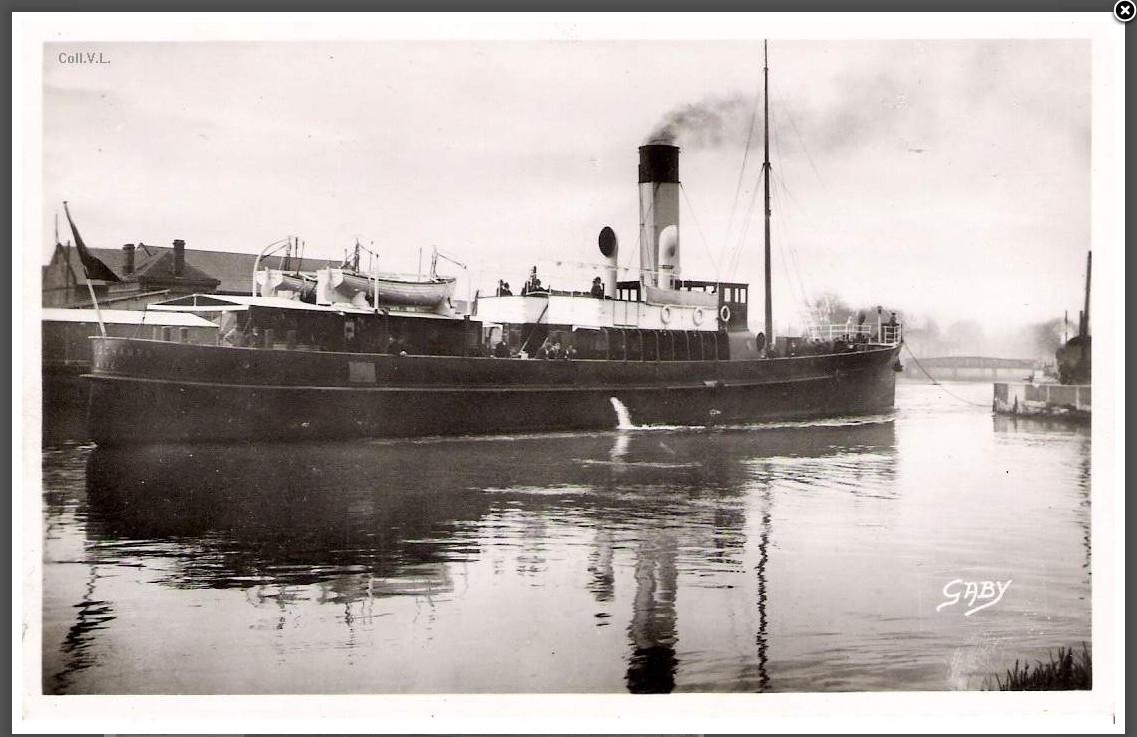
Photo above: l'Emile Deschamps. Civilian vessel, commissioned as minesweeper by the French navy before the war.
Below: Vredenhof cemetery situation after Dunkirk and the sinking of the Emile Deschamps. 30 July 1940 - early 1941.
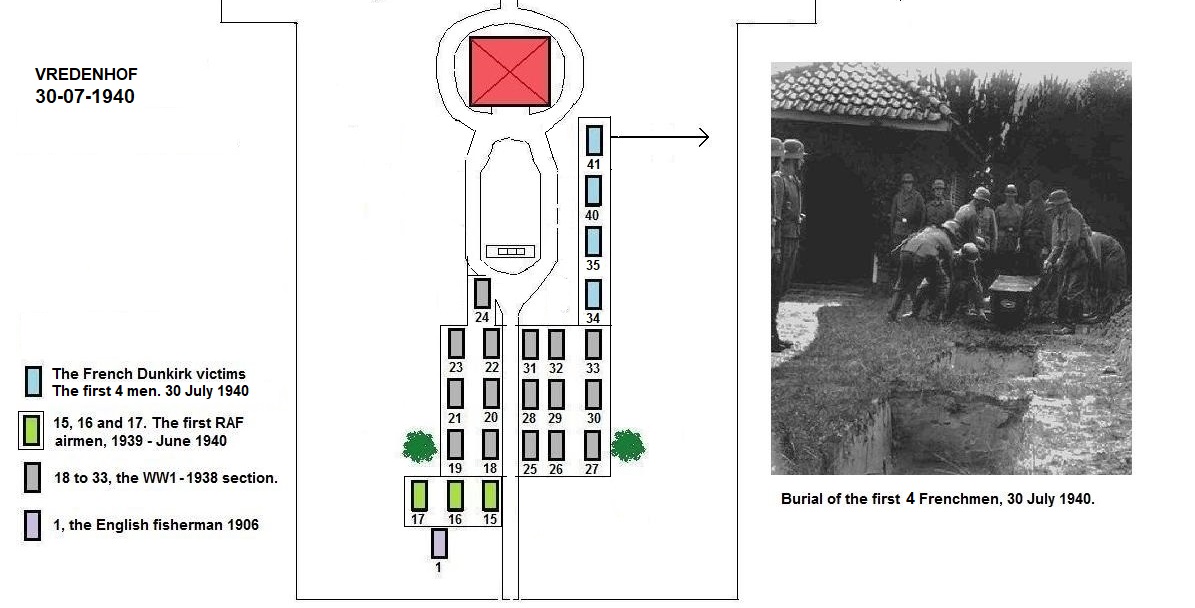
--

---

Dozens of French Dunkirk casualties are named on the French monument in their Dutch war-cemetery in Kapelle (near Goes, Netherlands). Website MémorialGenWeb investigated the names on the Kapelle monument. Combined with our files this provides interesting information on the men that are and were buried in Vredenhof:
Grave 41 'Barbe' must be army driver soldier Pierre Marie André Barbe, born in Paris and living nearby in Montgeron. He is on the war monument in his town. Known is he was killed during Dunkirk, died in sinking of a ship ('mort lors du naufage') and washed up on a beach. Our research shows this beach was here.
Grave 40. Unkown French miltair. Washed ashore same moment (30 July 1940) with Barbe, Marquezy and Deloziere. Never identified. Still here in this grave, the other three were exhumed 1949 and returned to family in France. Today on headstone grave 40: 'Inconnu, 30.07.1940, mort pour La France' (Unknown, 30 July 1940, died for France).
Grave 35. KPT = Capitaine (Army Captain) Charles Joseph Marquézy. Born Rouen. Mayor of Roubaix. Highly decorated officer in and after WW1. Reserve-officer in WW2. Chevalier de la Legion d'Honneur, Croix de Guerre 14-18 et 39-40. It is known he was Dunkirk-evacuee on minesweeper Emile Dechamps and was killed when this ship hit a mine off Ramsgate in the night of 3 on 4 June 1940. Exhumed to a family grave in France 1949.
Grave 34. Pierre Deloziere. Also a Captain, but not recognized as an officer. They had found on him part of an address. Capitaine Pierre René Edouard Delozière, born in Boulogne-sur-Mer. Known 'died in sinking of a ship'. Buried here until 1949, reburied in France.
It is very possible all four men were evacuees on the Emile Deschamps and died 4 June when the mine exploded off Ramsgate near the English coast.
======================================================================================================================================================
2 August 1940

--
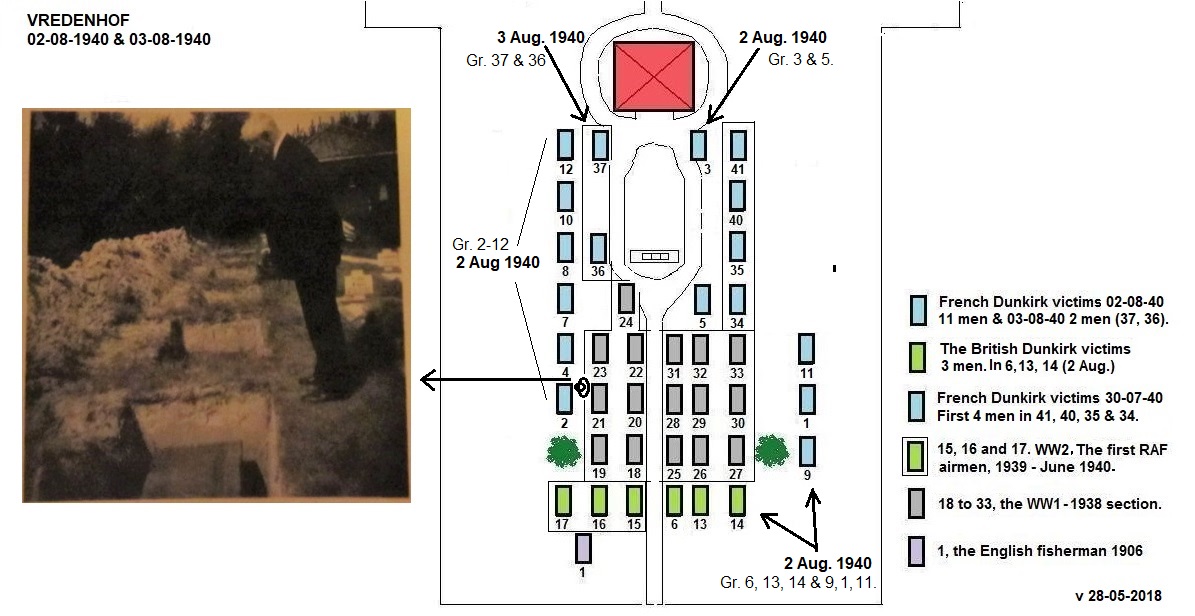
---
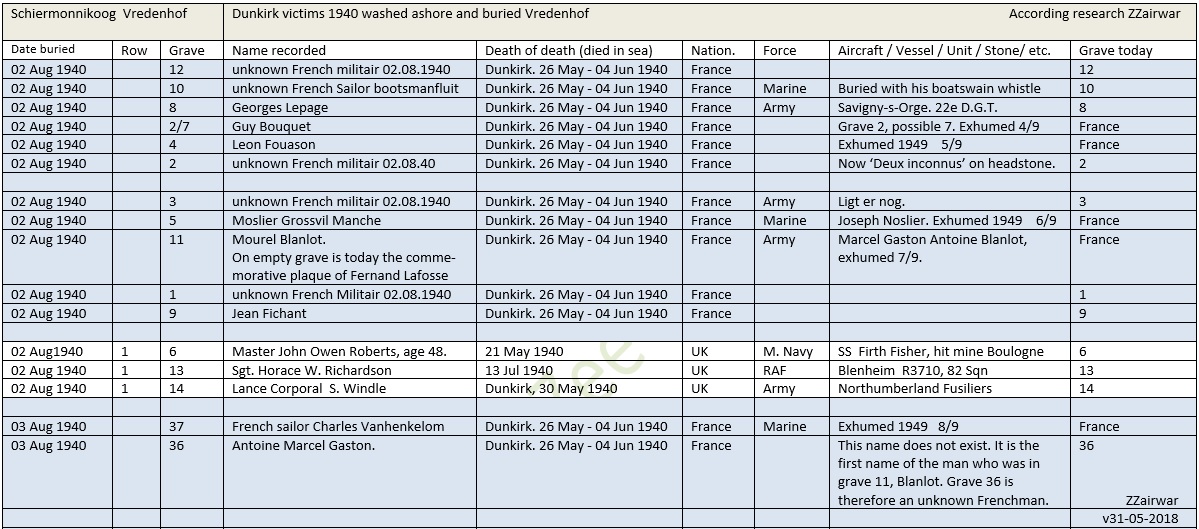
French buried 2 and 3 August 1940:
Grave 12. Unknown French militair, buried 2 August 1940.
Grave 10. Unknown French sailor, buried 2 August 1940. He was buried with his boatswain whistle. This was mentioned on his original grave marker (see image below). We believe he is a member of the crew (non-commissioned officer) of the Emile Dechamps.
Grave 8. Georges Lepage. Soldier, Army, 22e D.G.T. (Depot Guerre Train). Killed in sinking. Had adres on him in Savigny-sur-Orge, born in Chatou.
Grave 7. Guy Bouquet. French soldier Guy Yves Louis Bouquet, born in Derchigny. 3e C.R.T. Compagnie Regionale du Train. Guy Bouquet was exhumed in 1949 and reburied in France. More soldiers of his unit were found on the beaches in this area, mixed with crew of the Emile Dechamps. Marcel Blanlot in grave 11 is also 3e C.R.T.
Grave 4. Leon Fouason. French militair. This man was exhumed in 1949 and reburied in France. His real name is probably a little different.
Originally his name was recorded as 'Leon Foudson'. On the monument in Kapelle is 'L. Fondson'. Unclear case. Was it 'Fouasnon'?
Grave 2. Unknown French militair, buried 2 Aug. 1940. Today this grave has a stone with 'Two (Deux) unknown French, 02.08.1940, Mort pour La France'.
Originally there is no record or mentioning of two soldiers in this grave. Photo shows one coffin.
Did the grave number caused confusion? Was something added in the grave during the 1949 exhumation?
Grave 3. Unknown French militair, buried 2 August 1940.
Grave 5. "Moslier Grossvil Manche". This was second maitre Radiotélégraphiste Joseph Louis Francis Noslier. They found on him parts of an address: village Grosville (near Cherbourg) in departement Manche. This was written on his original grave marker, they thought it was part of his name. He was stationed in Dunkerque in Fort Louis (Castelnau), but he was also on the Emile Deschamps, died in its sinking on 04 June 1940. He was exhumed in 1949 and was reburied in France, Cancale 25 August 1949.
Grave -. Fernand Rene Lafosse. Soldier 3 ème Armée Service Corps. Born in Normanville, died in sinking 4 June 1940. His grave is lost.
Grave 11. "Mourel Blanlot" was originally recorded. This was Army soldier Marcel Gaston Antoine Blanlot, 3e C.R.T. (as Guy Bouquet in grave 7). Blanlot died in sinking ('mort lors du naufrage') on 04 June 1940. This was no doubt on the Emile Dechamps (sunk 04 June 1940, time 06:20). Blanlot was exhumed in 1949 and reburied in France, Courseulles-sur-Mer (Juno Beach, Normandy).
Grave 1. Unknown French militair, buried 2 August 1940.
Grave 9. Jean Fichant. Crew of the Emile Dechamps. He was sailor (matelot) and radio operator. Born in Levallois-Perret near Paris. He was not exhumed and still rests in grave 9 in Vredenhof. On the Kapelle monument is a 'Fichaut, G.' Nothing is known on this name, it is probably a wrong spelling of Fichant, J.
Grave 37. Charles Vanhenkelom. Buried 3 August 1940. Sailor and mechanic on the Emile Dechamps. Also stationed in Fort Louis (Castelnau) in Dunkerque. Died in the sinking 04 June 1940. Exhumed in 1949 and reburied in France, Saintines (Oise).
Grave 36. "Antoine Marcel Gaston". Buried 3 August 1940. This man was not identified in 1940 and 1949. We believe that this name does not excist. And does not belong to the man in this grave. This because Antoine Marcel Gaston is the first name of Marcel Gaston Antoine Blanlot in grave 11.
===========================================================================================================================================================
8 August 1940
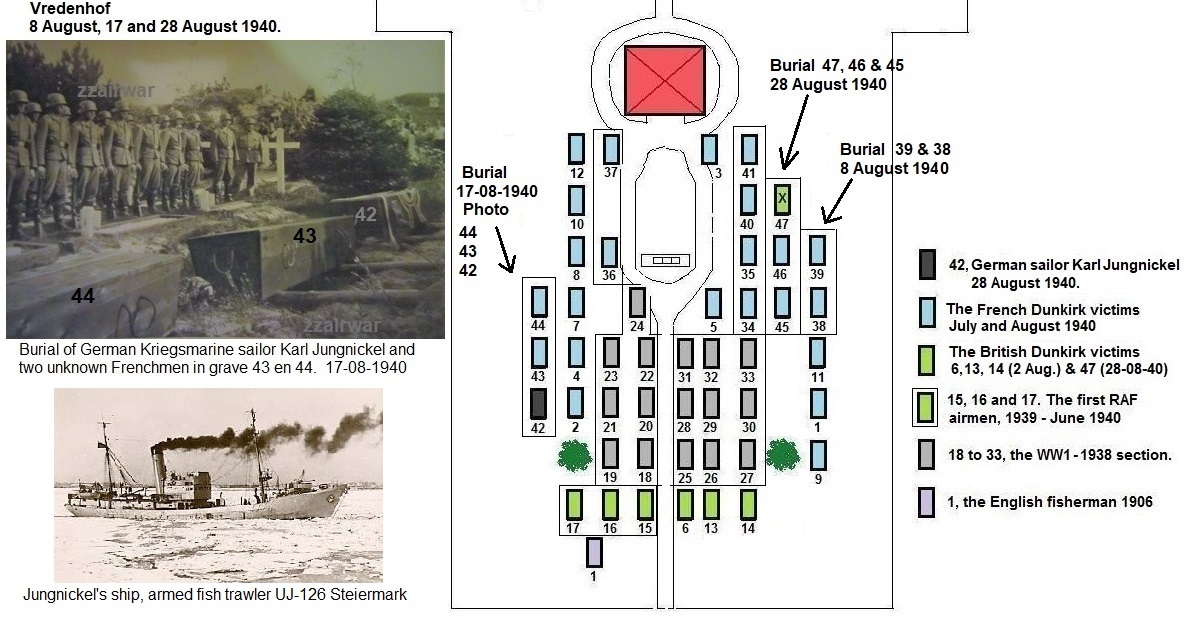
--
---
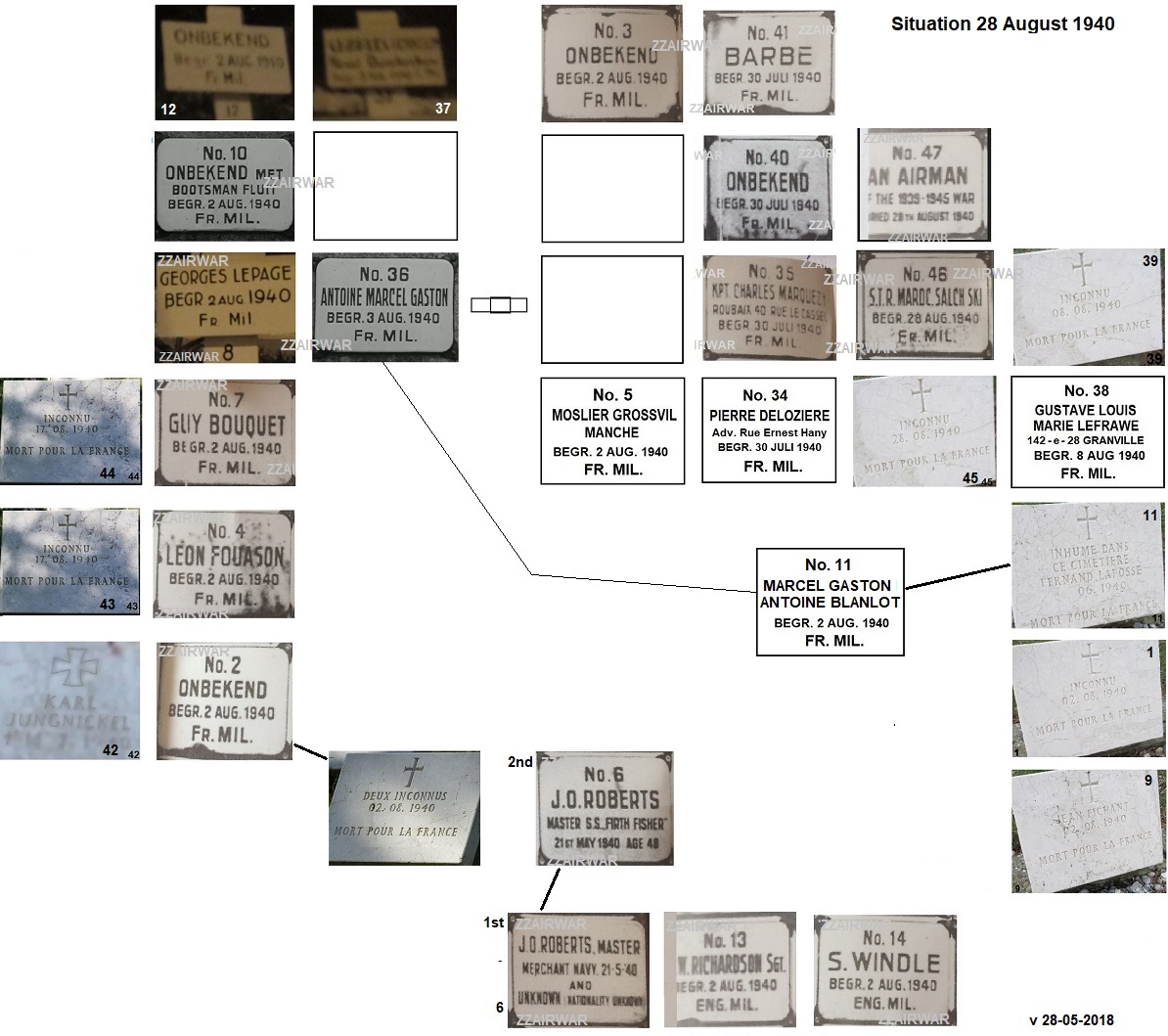
Grave 39. Unknown French militair, buried 08.08.1940.
Grave 38. "Gustave Louis Marie Lefrawe, 142-e-28 Granville". Buried 08.08.1940. This was Quartier-maitre fusilier Gustave Louis Marie Lefranc. He was born in Gênets, exhumed in 1949 and reburied in Gênets (just east on the coast of Mont St. Michel, France). His name is on the Monument au Morts in Dragey-Routhon, which is on the road from Gênets to Granville. He was crew on French navy destroyer Jaguar. She was set on the beach of Malo-les-Bains after a torpedo hit her on 23 May 1940. Apparantly Lefranc came after that as evacuee on the Emile Deschamps, because he sank with her on the 4 of June 1940.
Grave 44 and 43. An unknown French militair in each grave, buried 17 August 1940.
Grave 42. German sailor Karl Jungnickel. First German WW2 casualty buried here. More info on him further below.
Grave 47. Unknown English militair. Buried 28 August 1940. Received 'An Airman' on later emanel plate (see above), but in contrast to the other British airmen here, 'Royal Air Force' was never engraved. This meant they were not sure if he was RAF. Maybe a Royal Navy pilot.
Grave 46. "S.T.R. Maroc Salch Ski". Buried 28 August 1940. No doubt a Dunkirk evacuee on the Emile Dechamps. The text on the headstone means: "5e Tirailleur Régiment Marocains (5th Moroccan Rifle Regiment). In later documents 'Ben' was added. Last name of this unknown French-Maroccan soldier could be Ben Salch or Ben Salah. The 5e RTM was at the Luxembourg border at Thionville, but had to retreat and fought on in the area of Valenciennes near the central Belgian border, later remnants of this unit escaped via Dunkirk, of which this soldier was one. Unfortunally at the English coast, just before entering the Thames estuary at Ramsgate, the Emile Dechamps hit a mine and sunk within seconds.
Grave 45. Unknown French militair, buried 28 August 1940.
========================================================================================================================================
5 September 1940, Plot 2
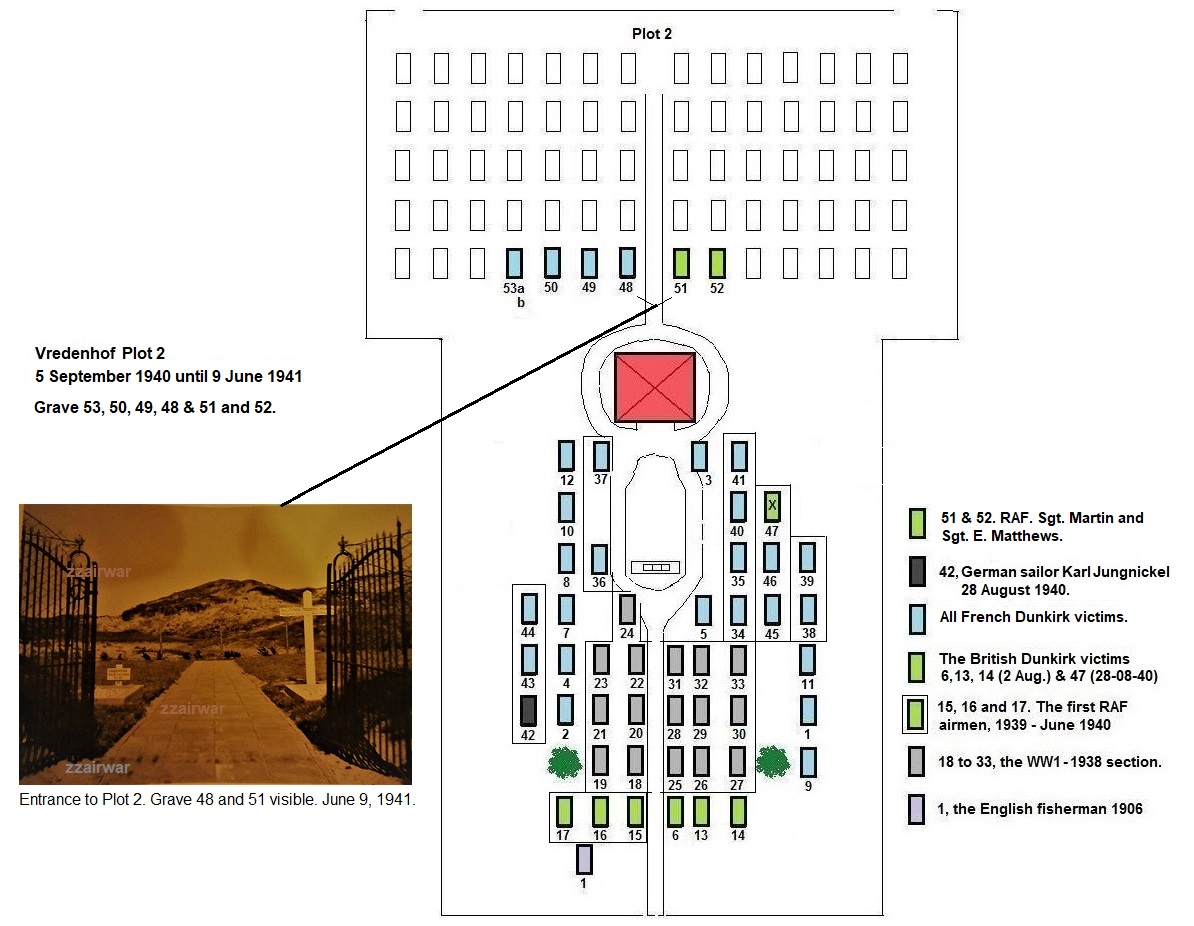
Name list 5 September 1940

Gravemarkers of the above men.

Grave 48. Unknown, buried 5 September 1940, Fr. Mil. Unknown French militair. Dunkirk victim.
Grave 49. Unknown "dressed in black coat, blue trousers and rubber boots, buried 14 Oct. 1940". Today on headstone 'Unknown French, 14.10.1940, mort pour La France'. No doubt a French sailor, Dunkirk victim.
Grave 50. Unknown, buried 3 December 1940. French militair.
Grave 53. Double grave. Re-buried here 9 June 1941. Two French Dunkirk casualties, buried before begin August 1940 in another location near the sea. Later names on headstone here: Raymond Feret and Pierre Lefebvre. Raymond Feret was French Navy Quartier Maitre Radiotélégraphiste, stationed in Fort Louis (Castelnau) in Dunkerque. He was evacuee and killed in the sinking of the Emile Deschamps on 4 June 1940, as was Pierre Lefebvre, no rank or unit of him is known. They have as date of death 01.06.1940 on headstone, but this shoud have been 04.06.1940.
=================================================================================================================================================
Photos below: left the three RAF airmen that were buried first, William Martin, Alan Wilson and Ryan. Right the crosses of three British that were found between the washed ashore French Dunkirk victims on 2 August 1940. The names on the crosses, left to right: J.O. Roberts, H. Richardson and S. Windle.
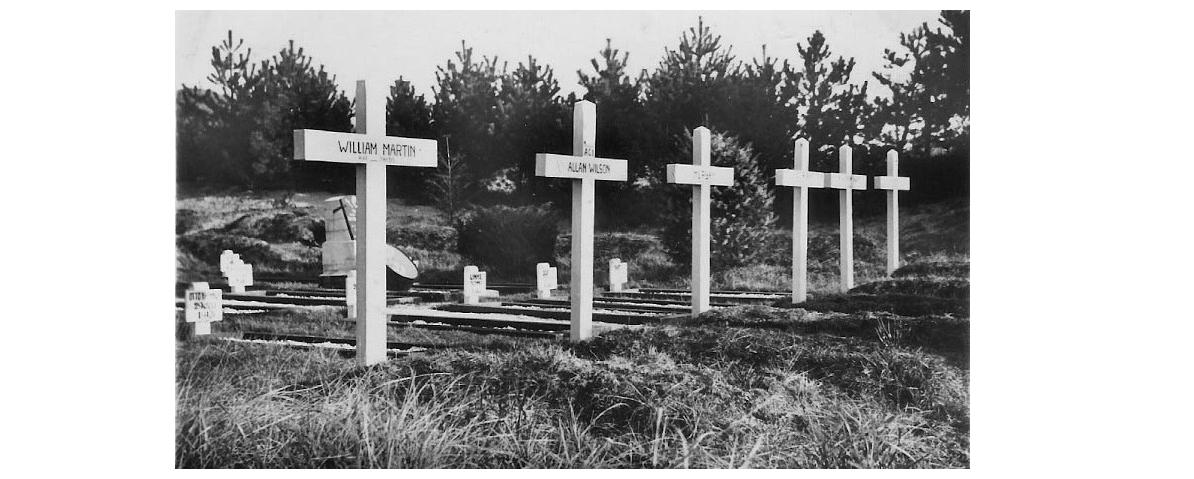
.
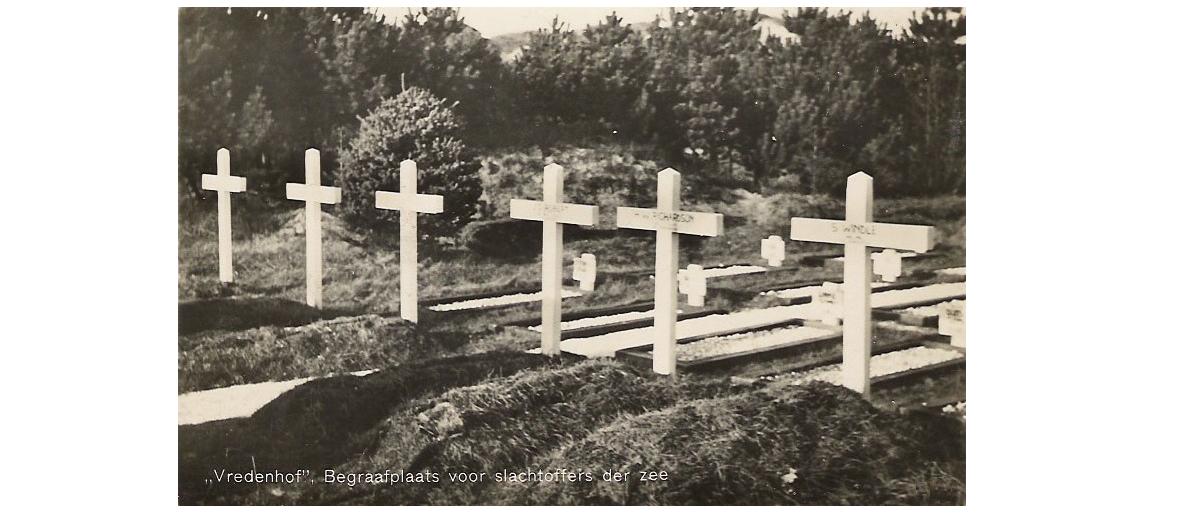
Above. Three casualties on 2 August 1940 were British and kept together in the large burial ceremony. They were buried on the right hand side of 'the English row', in line with the earlier buried William Martin, Alan Wilson and Michael Ryan. On the fresh crosses is painted 'J.O. Roberts', 'H.W. Richardson' and 'S. Windle'. Service number and burial date are witten under the name.
The French and the three above drowned in the North Sea on different dates, but were delivered here by the sea-current in one group on the same day.
The French drowned 3 June 1940 off Ramsgate, Master John Owen Roberts (age 48) was on the SS Firth Fisher. This steamship delivered supplies for the British Army in Northern France. A week before the Dunkirk evacuation, she hit a mine off Boulogne and sank May 21, 1940. Lance Corporal Swindle of the Northumberland Fusiliers is a Dunkirk-evacué and was killed in the middle of the Evacuation on May 30, 1940. RAF Sgt. Horace W. Richardson has no link with Dunkirk. He was navigator in Blenheim R3701 and was shot down by Flak on a Northsea-patrol Dutch coast/Amsterdam on 13 July 1940. His pilot and gunner are MIA -> relation with grave 47 is possible.
NATIONAL FLAGS.
After the burials of the French and English military, on the 17th Agustus 1940 the German occupation troops could bury their first countryman. It was Kriegsmarine sailor Karl Jungnickel (grave 42). With him also two unknown French Dunkirk-victims were buried. At that moment, the cemetery had no French flag yet (see coffin in the door), but some time later they obtained one (see photo further below). Obviously the Germans had a flag for Jungnickel: their war flag, the so called 'Reichskriegsflagge' (photo below). It became customary for every burial to cover the coffin with a national flag and burial with some kind of military honour.
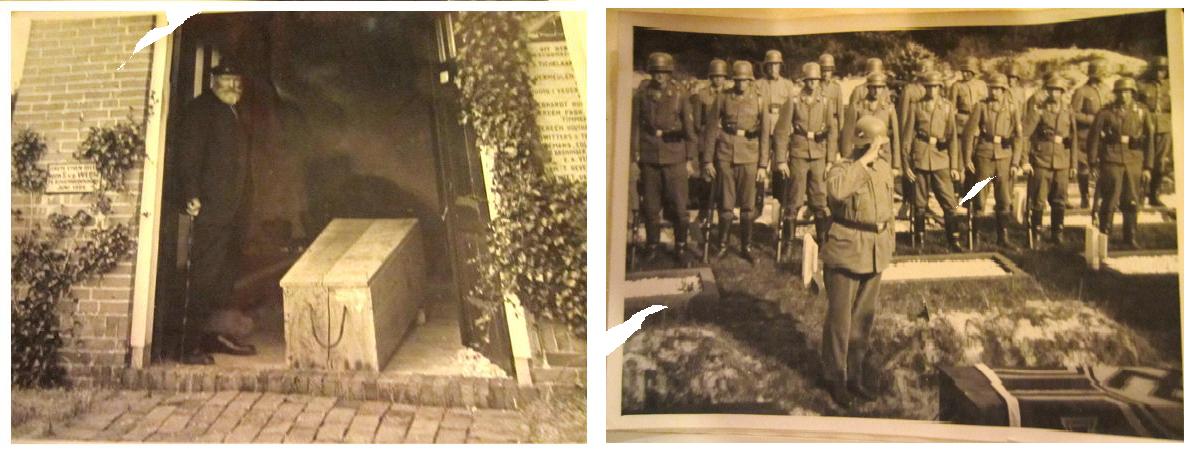
DRIFTWOOD.
Note the above coffins are made of sanded driftwood. Driftwood was the only source of wood on the island. Regular coffins were already used up. Handles were also beach-finds; ropes made on the same length. On above photo the Frenchman is buried in a coffin of natural coloured planks. Karl Jungnickel (same ceremony) received a coffin of darker planks, also driftwood.
KARL JUNGNICKEL. FIRST GERMAN WW2 BURIAL HERE.
It tooks us some time to trace the history of Karl Jungnickel. He was aboard German anti-submarine ship UJ-126 that was torpedoed by Royal Navy submarine HMS H31 (Lt. Wanklyn) on 18 July 1940. This was 16km northwest of Terschelling Island, about 75km west of this cemetery. The UJ-126 of the 12th Unterseeboots-Jagd Flotille was the former German civilian fishing trawler 'Steiermark' and was coverted to submarine hunter. Karl Jungnickel was buried on 17 August, his body was on sea for a month and the sea added his body to the group of French Dunkirk casualties of the Emile Duchamp that died off Ramsgate and entered the sea on June 4, 1940. The wreck of the UJ-126 was discovered in 1985 and her cannon ended-up in a museum on Terschelling Island.
GRAVEMARKERS.
The original grave marker on Vredenhof was the small square white wooden sign with painted black text. In 1940, only the first 6 English casualties received white crosses. Already before 1945 every grave had received an enamel (emaille) plate with grave number, name and other details, fixed to a small concrete base. Because the enamel plates were stolen, they were replaced in recent years by marble plaques, solidly constructed onto the original concrete base. In 1948, only the Commonwealth casualties received an additional white steel cross, but these have not been there for a long time (rust). See photo of these steel crosses further below.
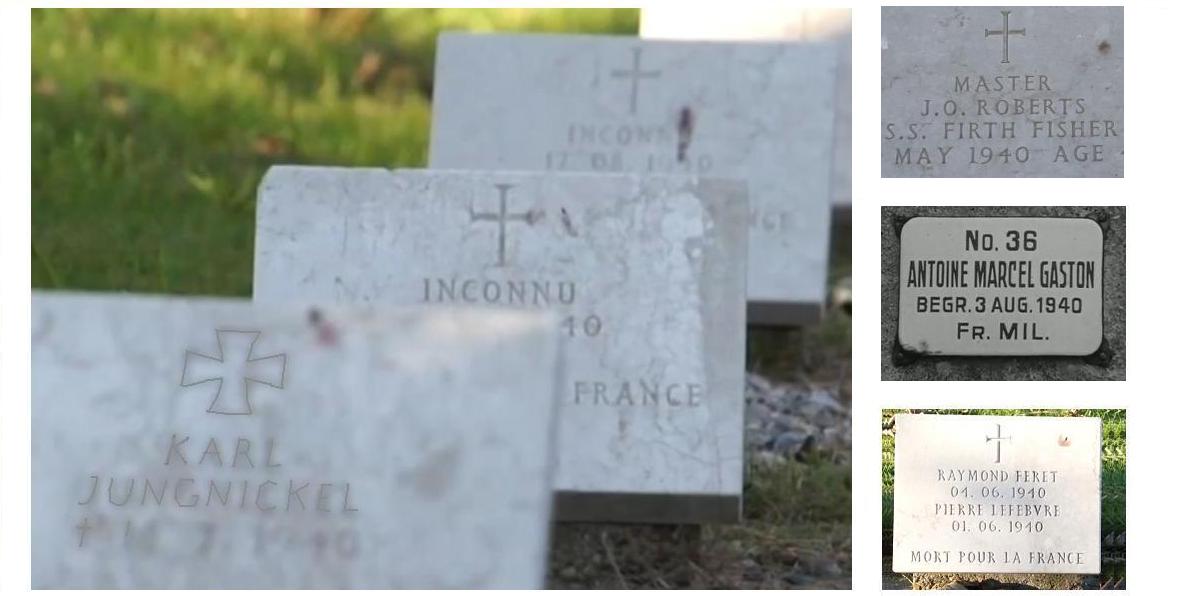
Below photo: POW French troops in Dunkirk, June 4th 1940. Below group is typical for what the Emile Deschamps had on board and is buried here: navy crewmen of the ship itself + remnants of French-Moroccan rifle regiments and their French NCO's and individual soldiers from all kinds of French army units.
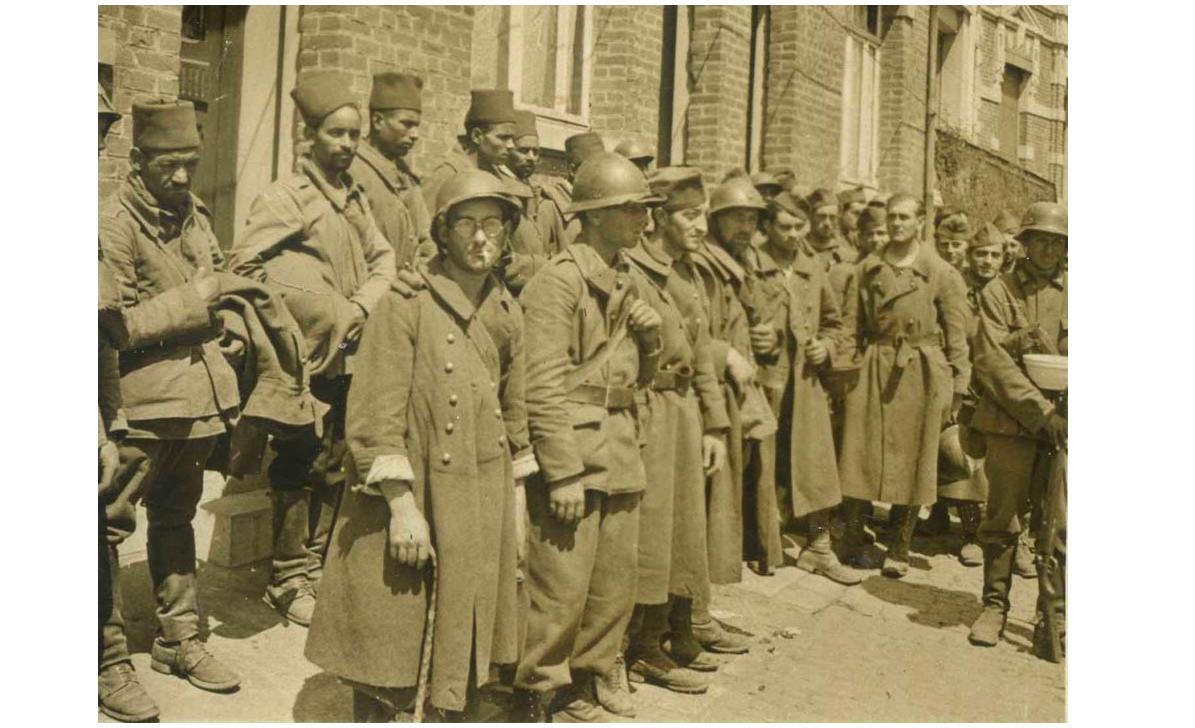
1940 Dec - 1941 January
The first burials on plot 2. Now with new acquired French national flag, small military escort at grave 50, unknown French soldier. Right: Grave 51, RAF Sgt. Stephen Martin. The Frenchman was buried begin December 1940, temperature still OK to wear normal battle-dress. During Martin's funeral a few weeks later in January 1941, it had snowed and the German soldiers are cold.
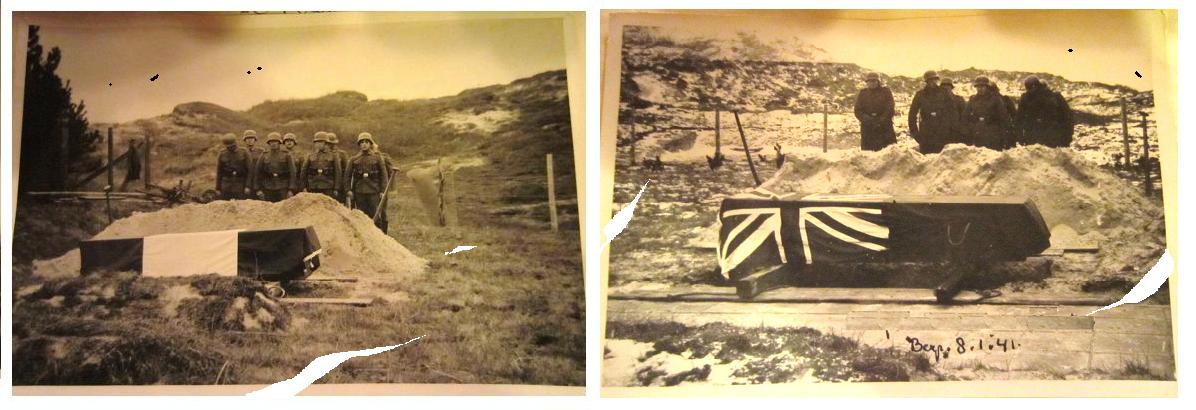
1941
Photo below: German troops are walking towards plot 2 for attending a funeral with large military display. Date is 7 August 1941. Notice on below photo that all French graves on plot 1 are in position. The last empty spaces on plot 1 will be filled in 1943.
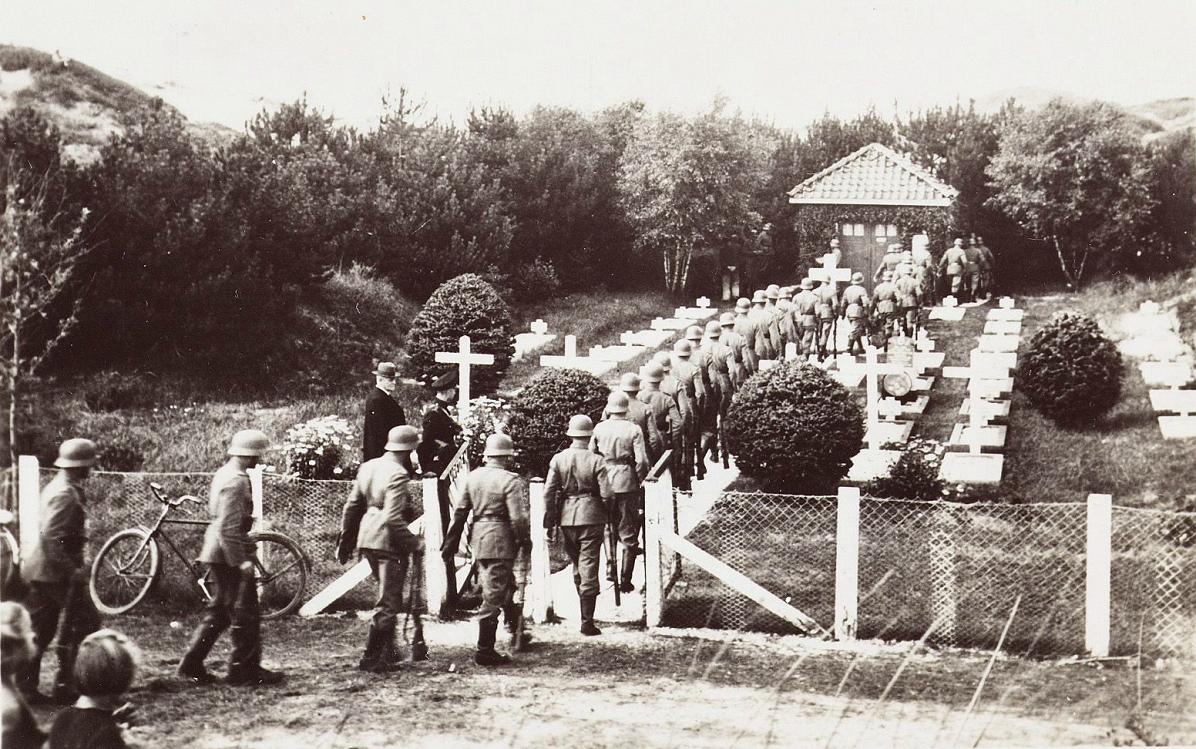
Photo below:
Military funeral on plot 2, August 7th 1941. The coffin stands on grave position 59. This is the grave of RCAF Sgt. William A. Strachan (Wellington R1063, 115 Sqn), shot down in the North Sea 7 July 1941. He washed ashore and buried a month later. This funeral served German propaganda, a drummer and a camera team are present. German interest for Allied burials gradually diminished.
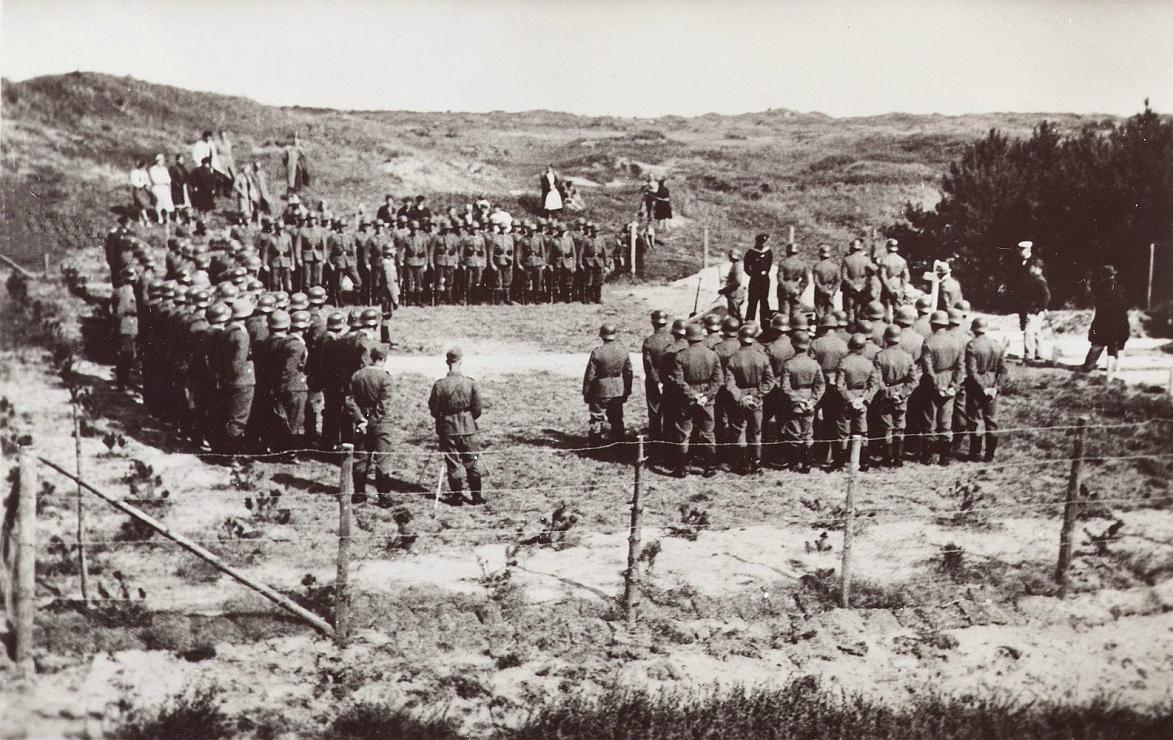
Photo below: on 4 September 1941 there was a funeral for washed ashore German pilot Oberfeldwebel Heinrich Schwiering (grave 61). At this funeral also a group of German navy sailors attended. A week later on 11 Sept, the cemetery and grave were inspected by this German naval officer. His rank is vice admiral. We believe he is Vizeadmiral Johannes Bachmann. He was Küstenbefehlshaber Deutsche Bucht, naval commander of this area from Feb. 1941 until June 1942. He was killed in April 1945 in a contact with American forces. On the right the grave monument and grave drum of Gerhard Spiessen are well visible.
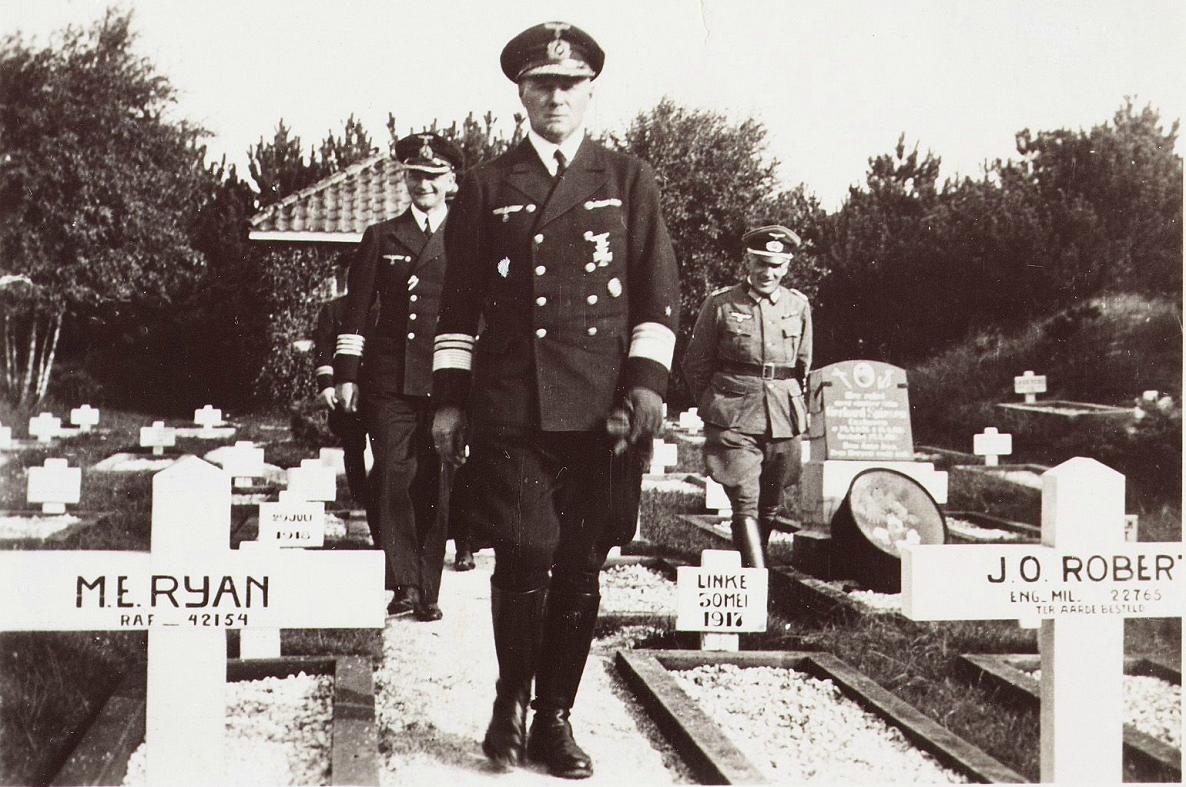
.
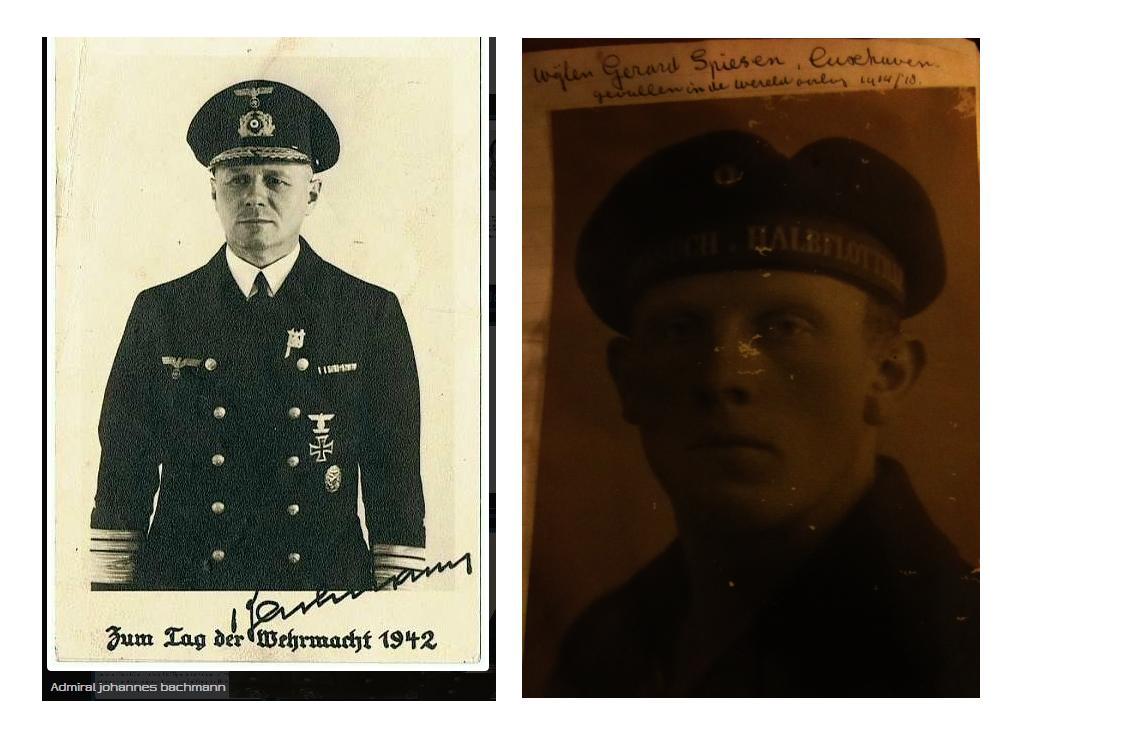
.

.

1943-1945 and 1949-1968, the last 22 burials on Vredenhof
In March 1943 burials had commenced on the last row on plot 2 (graves 96, 97 and 98). It became clear that plot 2 soon would be full, but WW2 was far from over. Decision was made to return to plot 1, first use the free spaces there and then go back to plot 2. In total 9 RAF airman got a position on plot 1, see blow list. In 1955, the caretaker of the cemetery and his son were buried on plot 2, back row on the last free spaces.
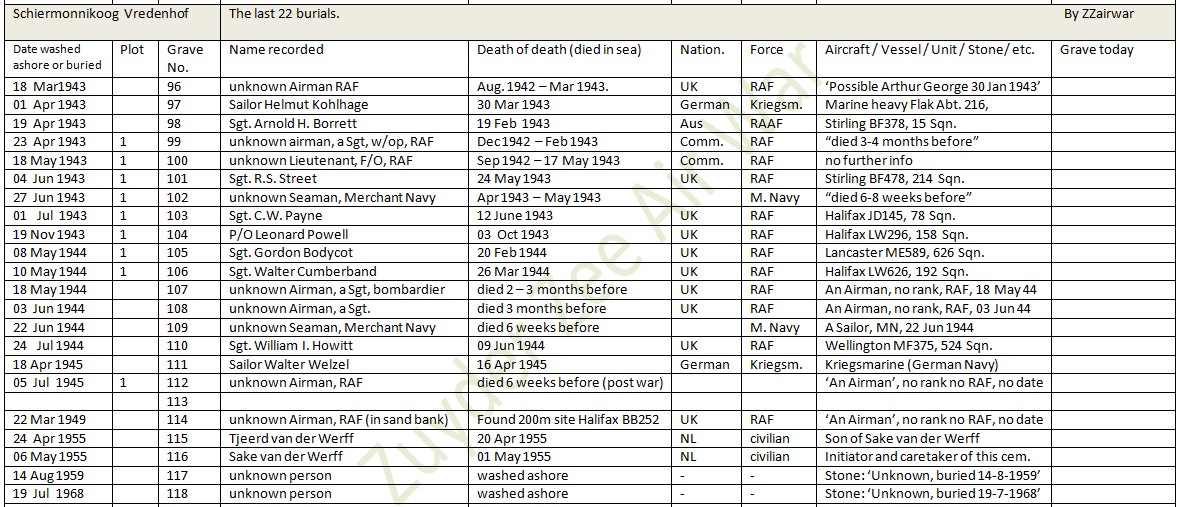
Grave 96. After the war, around 1950, the CWGC striked in their register the RAF-status of this unknown airman and set the date of death on '1943'. Found by Germans 16 March 1943 at pole 16. We believe there could be a relation with Halifax BB252 and the post war id-proces of Canadian RCAF F/Sgt. Laurence Clifford King (initially buried as unknown). Possibly King was moved in the process to 89 (next to his crew in 90-94) and an unknown airman, not RAF -1943, moved to grave 96.
Grave 112. On 5 July 1945, 2 months after VE-day (Victory in Europe Day May 8, 1945) Dutch resistance patrolled the beach and found near pole 16 a washed up body in very decomposed state. Died at least 6 weeks before. The resistance men were T. van Dijk and carpenter Leo van Veen. The corps had on a blue striped sporting shirt, brown shoes and a brown leather belt around the waist. In the low brown shoes was written 1941-5-9. No other ID or markings on the body. This man was buried in grave 112. This could have been next to Walter Welzel in grave 111, but is was done on a more prominent position on plot 1 left side of the entrance. Maybe based on the shoes on the grave marker came: "An Airman", without rank, without RAF or date.
Grave 113. There are no recordings found yet of a use of grave 113. Last burial was (number) 112. Remarkable is that there are no American airmen here. Also no records found so far on exhumed American airmen. This in contrast to the other Frisian Isles. Info welcome.
Grave 114, burial 1949. Halifax crew BB252 or not?
It was after severe storms on Saturday March 19, 1949 when Mr. Eelke Hoekstra and Mr. Simon Wijdenes saw near beach-pole 14/15 (beach pole 14/15 position in 1949) a military jacket sticking out of the sand. Inside was a skeleton. Police found a wallet and 4 English coins. However, nothing inside the wallet was readable. The airman remained unidentified. He had been about 20 years old. A hat or cap on the remains showed 'RAF'. Buried in this grave.
Newpapers 1949 published a press-release from unknown origin, stating that he was probably a crewmember of mine-laying Halifax MkII BB252 (10 Sqn). This bomber had tried to emergency belly land in darkness on 9 January 1943 on the frozen beach (18:15h). Crashed hard and broken apart in several parts, large and small (see photos underneath link Willem 626 Squadron), some parts were deep in the sand. This was at beach pole 15 (beach pole 15 position in 1943). According to the 1949-papers only five crew were buried of this aircraft: Fish, Wilson, Featherstone-Haugh, A. Smith and J.W. Smith. However, apparently it was forgotten or not known in 1949 that a sixth crewmember was buried same day as 'Unknown Sgt. Clifford' and that one man of the crew died in a hospital on the mainland, making the crew complete (7 men).
The day after the crash at 13:00h, the Germans recovered six men from individual wrecked sections. Two gunners were still alive, one died after taking him out of his position. Mutilated bodies in flying suits were then laid down next to each other on the frozen sand (German photo). Four men appear to be on the ground (at that moment), in stead of five. Wilson had his life-vest on and smashed-in face (German photo and doctors report). 'English' gunner 'Clifford or A L ford' was alive but unconscious, 20 years old. He died that evening (10 Jan.) in the medical barrack on the island at 22:00u. This must have been F/Sgt. Clement Lawrence Clifford King (post war identified). The six men were buried on 12 Januari 1943.
In book 'De oorlog in woord - Schiermonnikoog 1940-1945' by Bauke Henstra (2012) is an interview with Nico Faber stating that he remembered the day of the interment of the six well, it was a sad day. According to him, the 7th man Sgt. Boyle jumped out before and was found wounded by the Germans near the old footbal field. He was taken to the mainland to Leeuwarden Hospital, died there. This was 15 Jan. 1943, he rests there today. If all seven crewmembers were accounted for in January 1943, who then was the RAF airman found in the sand in 1949?
Newspapers in 1949 said that finding position of the 1949-body was only 200 meters from the 1943 crash site or pole 15. However, 200 meters is a considerable distance on a beach and area were so many airmen washed ashore in WW2. A link between Halifax BB252 cannot automatically be made, even if a crew member had been missing. The position of pole 15 has changed over the years. The old Dutch WW2 position of pole 15 was in the center of the Island. See map below, not at todays pole 15 position at 'De Balg'. Most probable is that the 1949-airman is a washed ashore airman period 1938-1947. The headstone inscriptures also point into this direction. In March 1974, again after severe storms, the Dutch Airforce Recovery Unit (Mr. Gerrit Zwanenburg) was called in to take a look at a Rolls-Royce Merlin XX (20) and a Halifax-wing that were uncovered by the storm at position pole 15,6 (position of pole 15-16 in 1974). The engine and the wing belonged to Halifax BB252.
Map below: Old km-poles (P) and the ones today (in red). 1km between each pole.
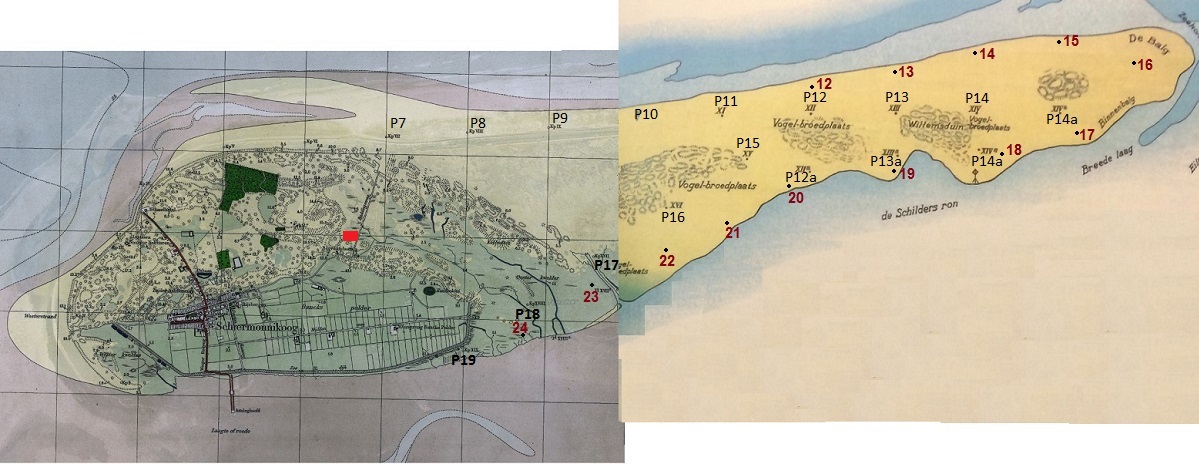
Grave 117. In 1959 the cross of sacrifice was build on plot 2. An unknown person that washed ashore in 1959 was therefore buried or re-buried in an never used grave on plot 1, between grave 37 and 36.
Grave 118. This person washed ashore in July 1968 and was identified August 2015. Dutch police (KLPD) and the Netherlands Forensic Institute (NFI) carried out a cold-case investigation on more than 500 Dutchmen that are listed as missing person since 1920. DNA was taken from unknown persons buried all along the coast and relatives of the 500 missing people. In this case a match was found with a family in Urk. The man in grave 118 proved to be Fisherman Albert Swaan from Urk. His ship the UK 91 was lost in a storm in January 24 January 1968 some 20km above Ameland island. He was 28 years old and had 4 children. Four crew are still missing. In total in 2015 five graves were examined and DNA taken: grave 23, 24, 33, 117 and 118.
Grave 115, 116 and 117. In 115 and 116 rests cemetery-initiator Mr. Sake van der Werff and his son. On the left hand side in grave 119 was interred in September 2014 the successor of Mr. Van der Werff: Mr. Jan Fischer. The 'E' on the top row of Plot 2 means never used grave. The 'E' in the blue graves on Plot 1 represent French graves exhumed in 1949, empty today.
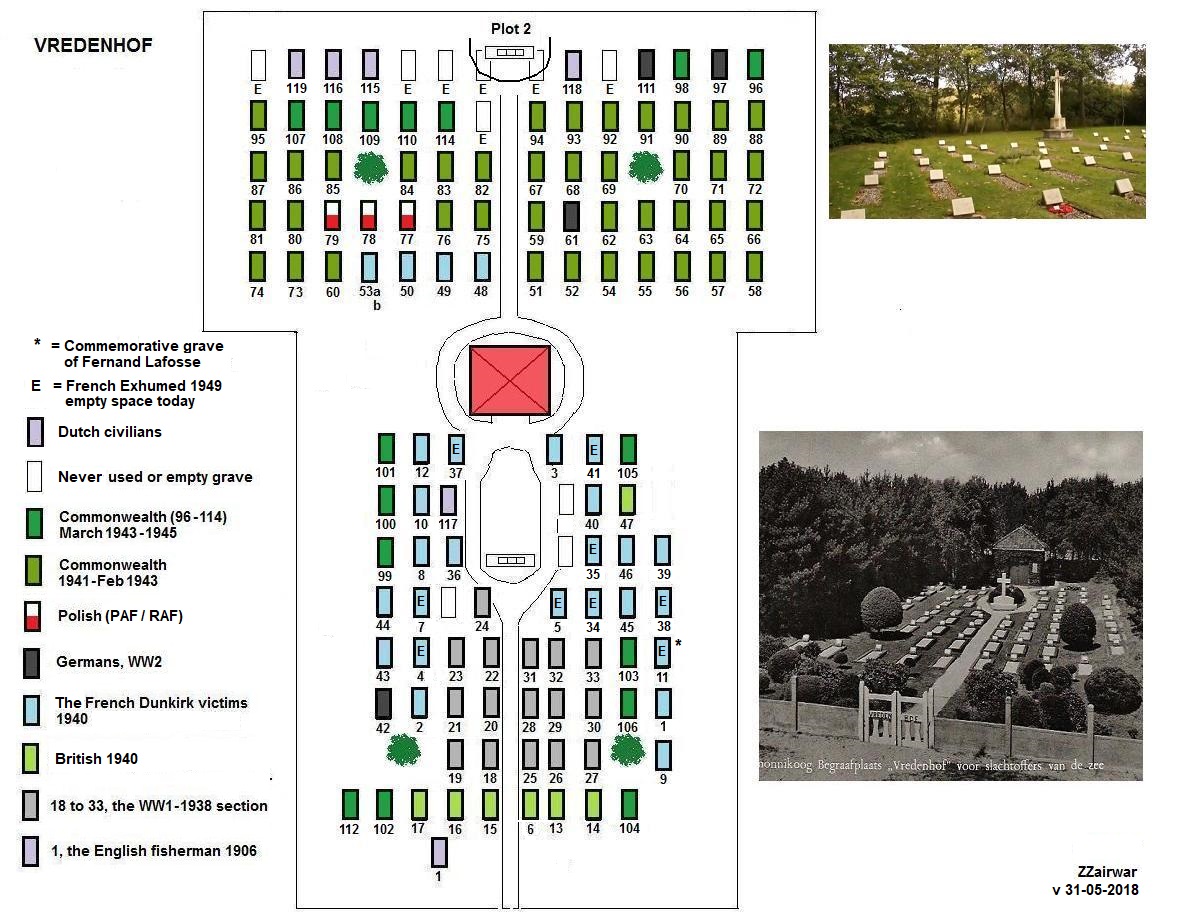
Polish

Read more on www.polishwargraves.nl/ned/schier.htm
1945
Below commercial postcard shows the situation end 1945. In that year the 1936-WW2 chickenwire fence and 'rising sun' gate were replaced by a cement wall and a new wooden gate with 4 white hourglass (sand timer) pillars. This would stand until 1957. The German sailor (1918) Gerhard Spiessen in grave 29 still has the large grave monument that his family placed in 1925, but within 5 years this would be removed and he got the standard stone.
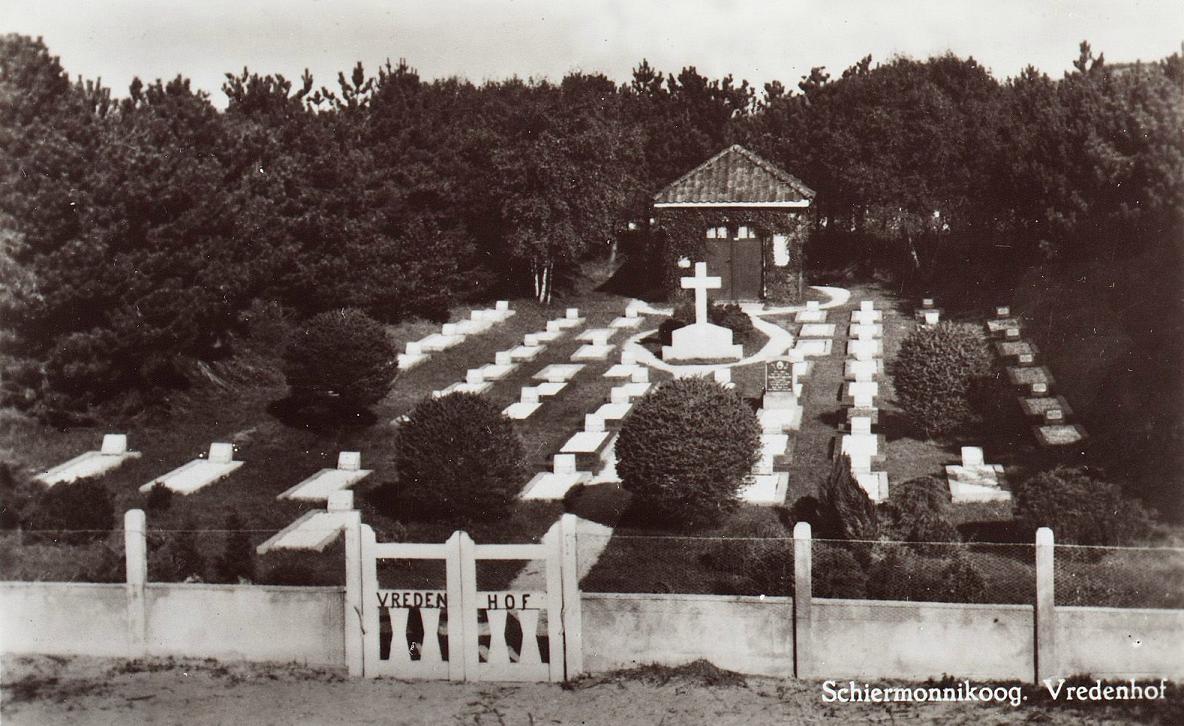
September 1945.
This is a meeting in which 10 men (9 soldiers of different nationality and a medical doctor or journalist) visit the cemetery. Most are high ranking Canadian officers, one of them is a general with 4 stars on his shoulder. One of the officers seems French. This is one photo of a serie of five.
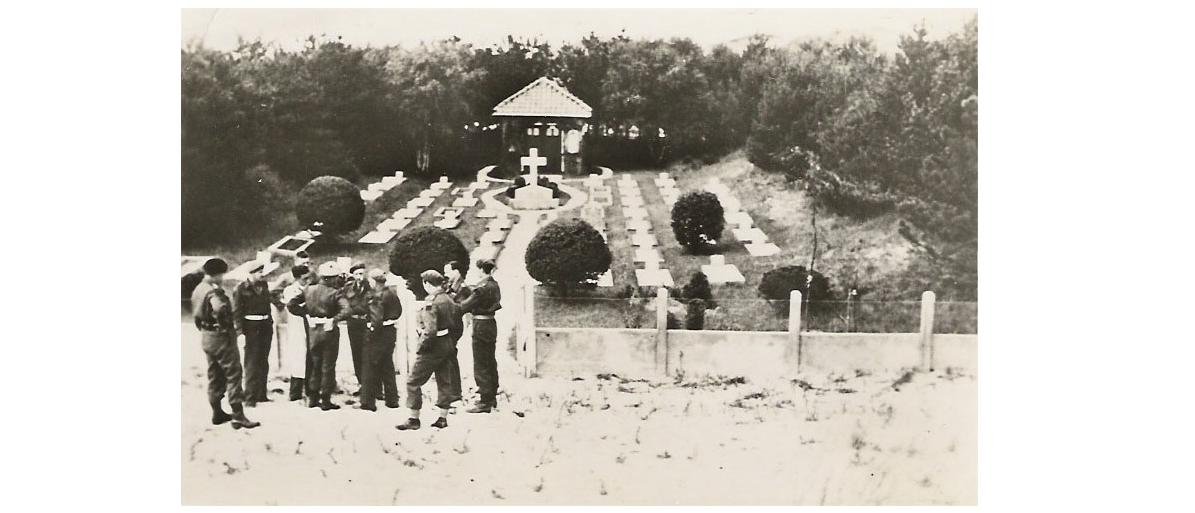
1947, Plot 2
On below photo there is no Cross of Sacrifice yet. The grave with large grave monument is of German pilot Heinrich Schwiering (grave 61). His wife arranged it during WW2. Soon after this photo was made, the monument was replaced by a standard Vredenhof headstone. Mrs. Schwiering visited the grave of her husband last time in 2002.
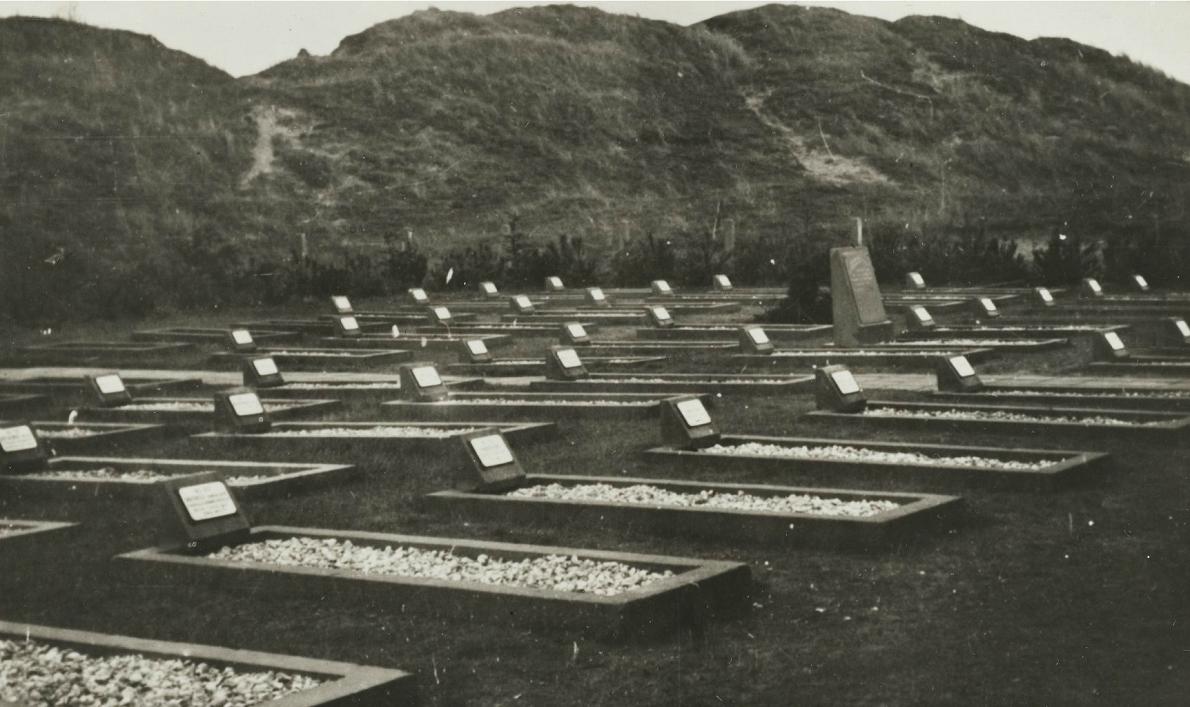
1948 - 1949
In 1948 every Commonwealth grave received an extra a white steel cross. They did not stand long. German pilot Heinrich Schwiering's monument is replaced. On 2 August 1949 the Dutch Army Grave- and ID Service in cooperation with the French, examined 14 French casualties. Nine of them were exhumed and returned to family in France.
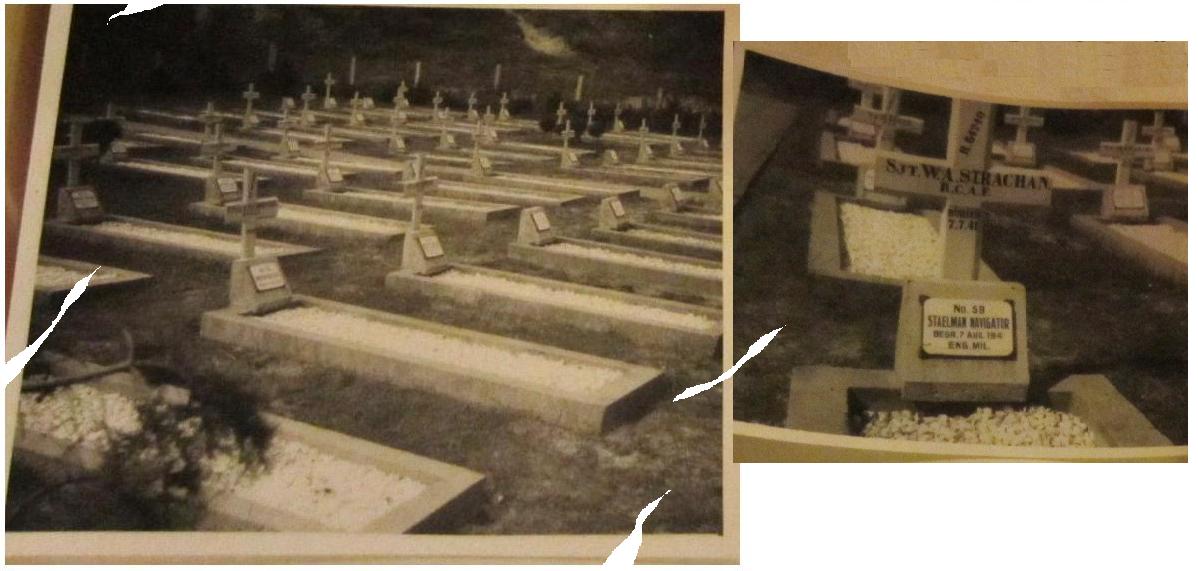
1957 - CWGC
Vredenhof was and is a private cemetery for washed ashore victims of the sea. Because of WW1 and WW2 it became mostly a war cemetery. Organizations from different countries tried to take over control, but Mr. Sake van der Werff kept it independent. After his death in 1955, the management could not resist an offer by the CWGC for a new entrance. On Plot 2 the Cross of Sacrifice was placed for the cost of a grave position on each side of the cross.
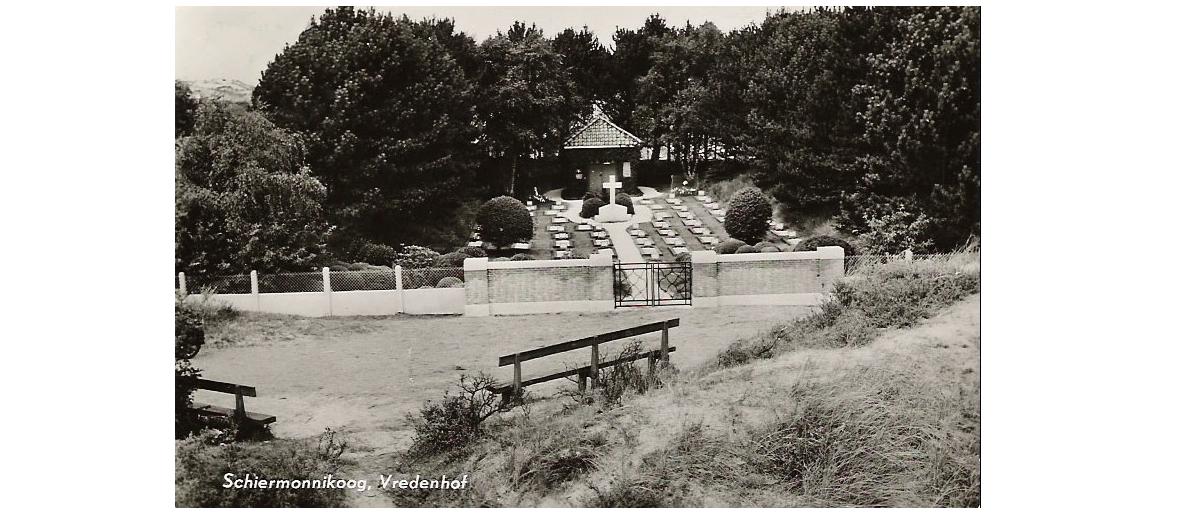
.

Today. The German Wasserman-radar bunker, highest point on the Island. Overlooking the path to cemetery Vredenhof.
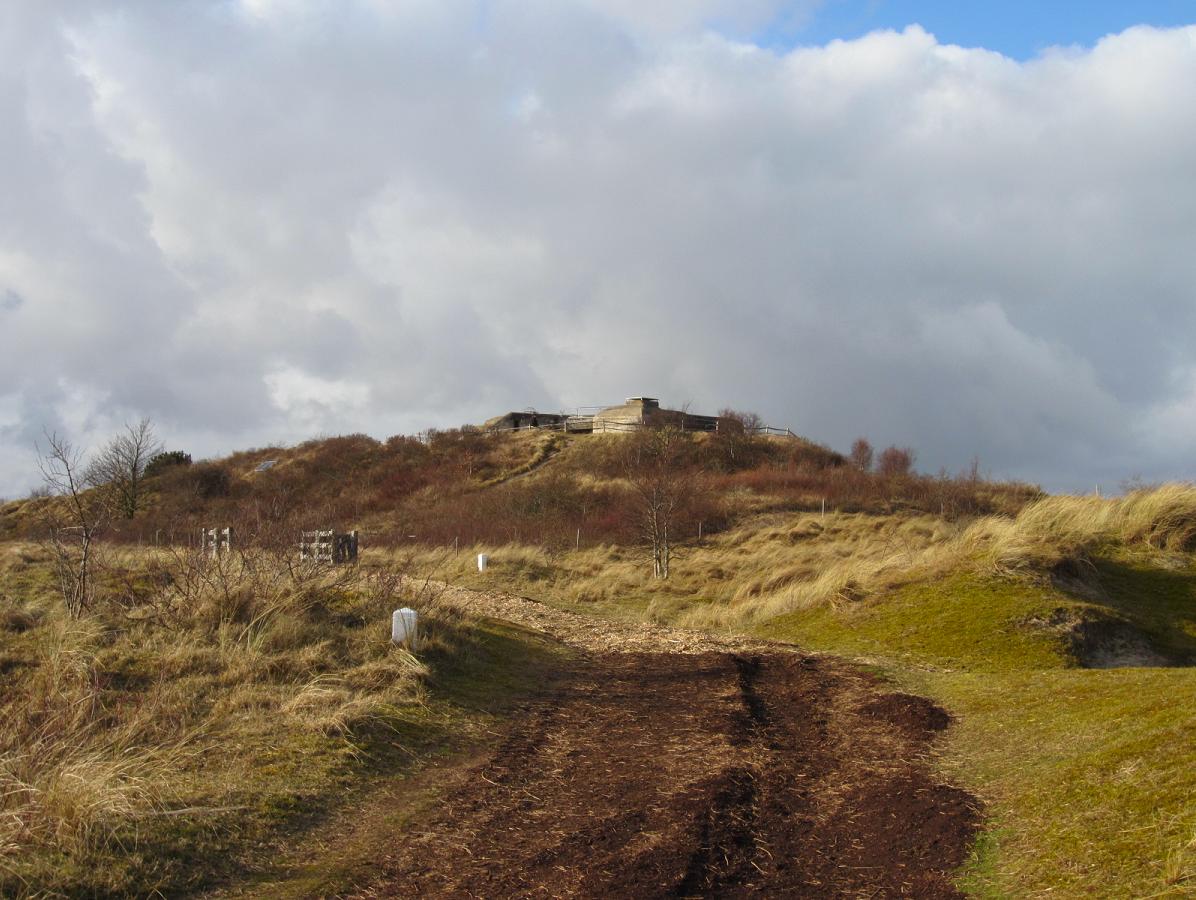
.
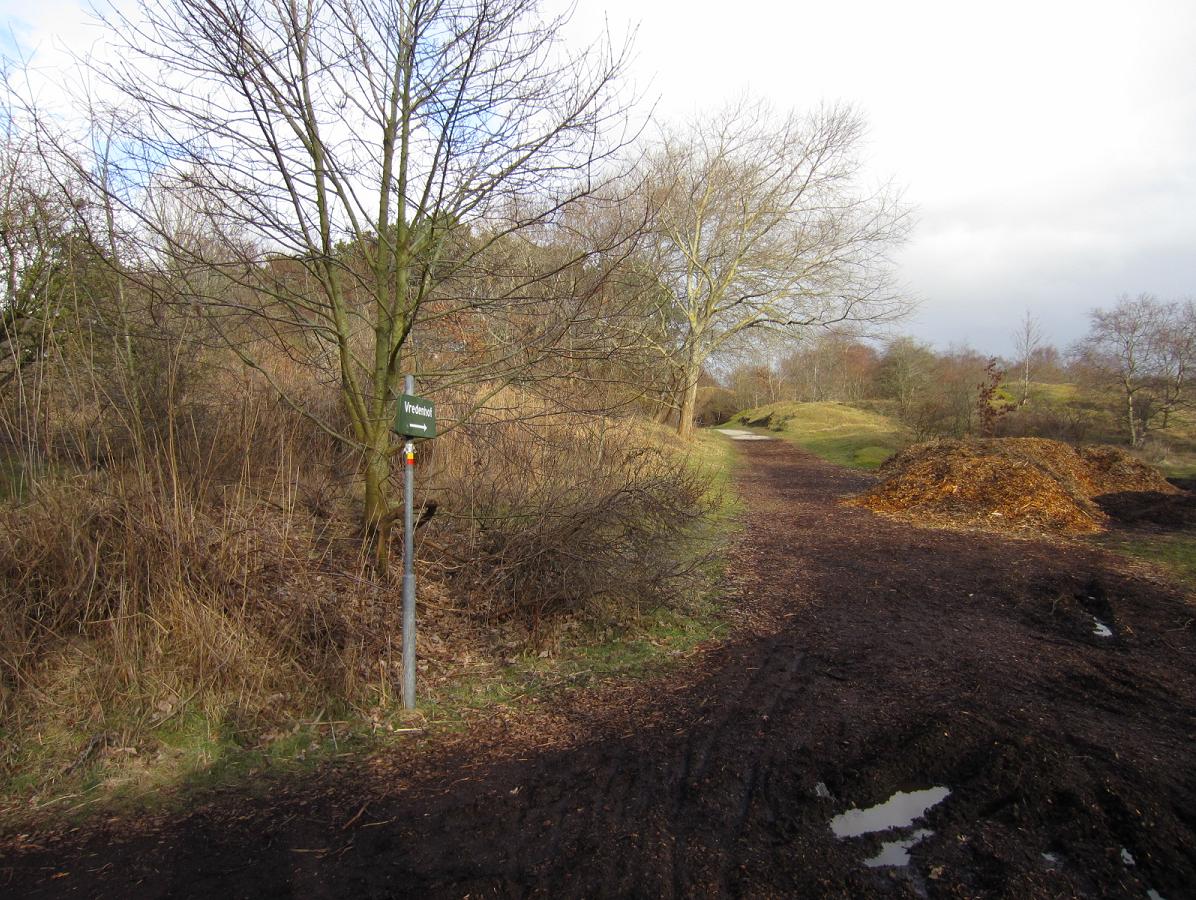
.
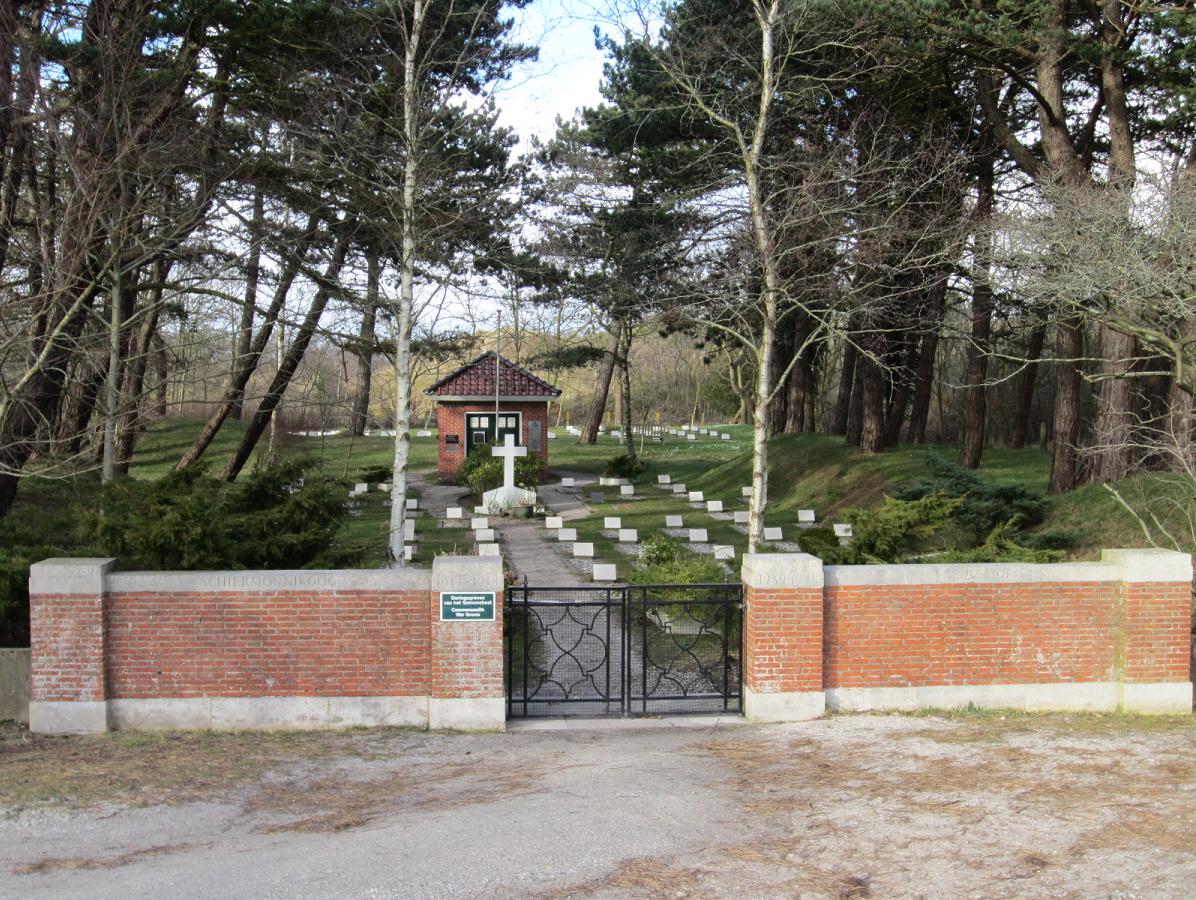
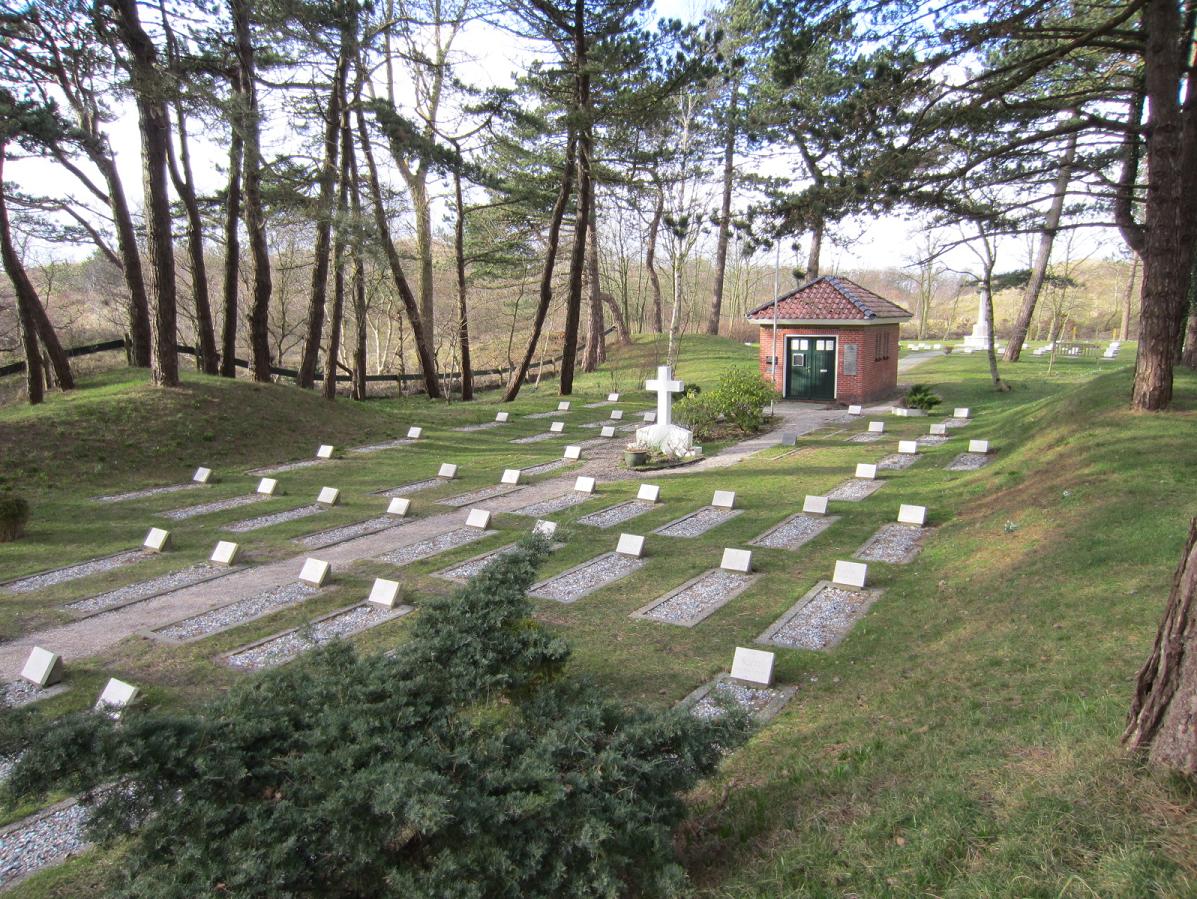
The low dunes on the sides are man-made. They must prevent seawater coming via the old sea-inlet during very high tides.
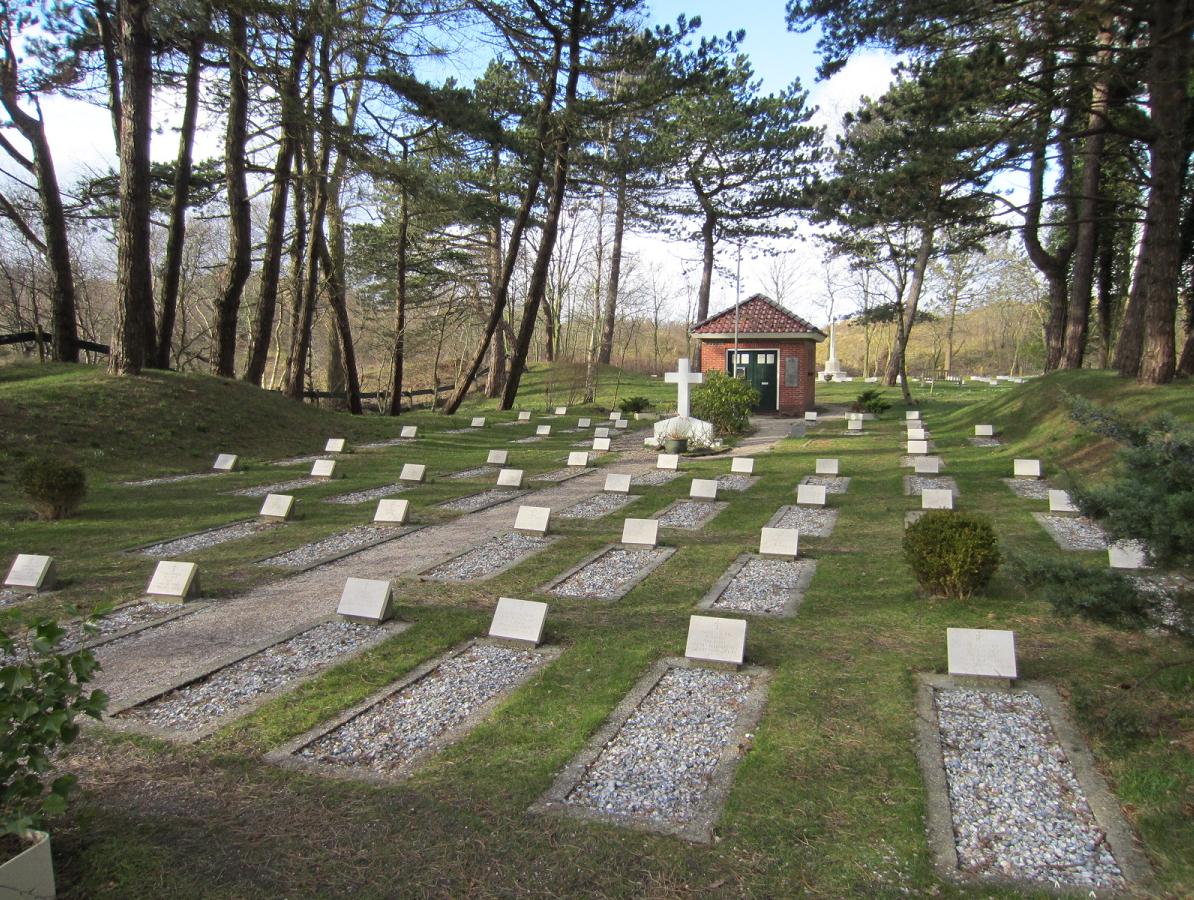
.
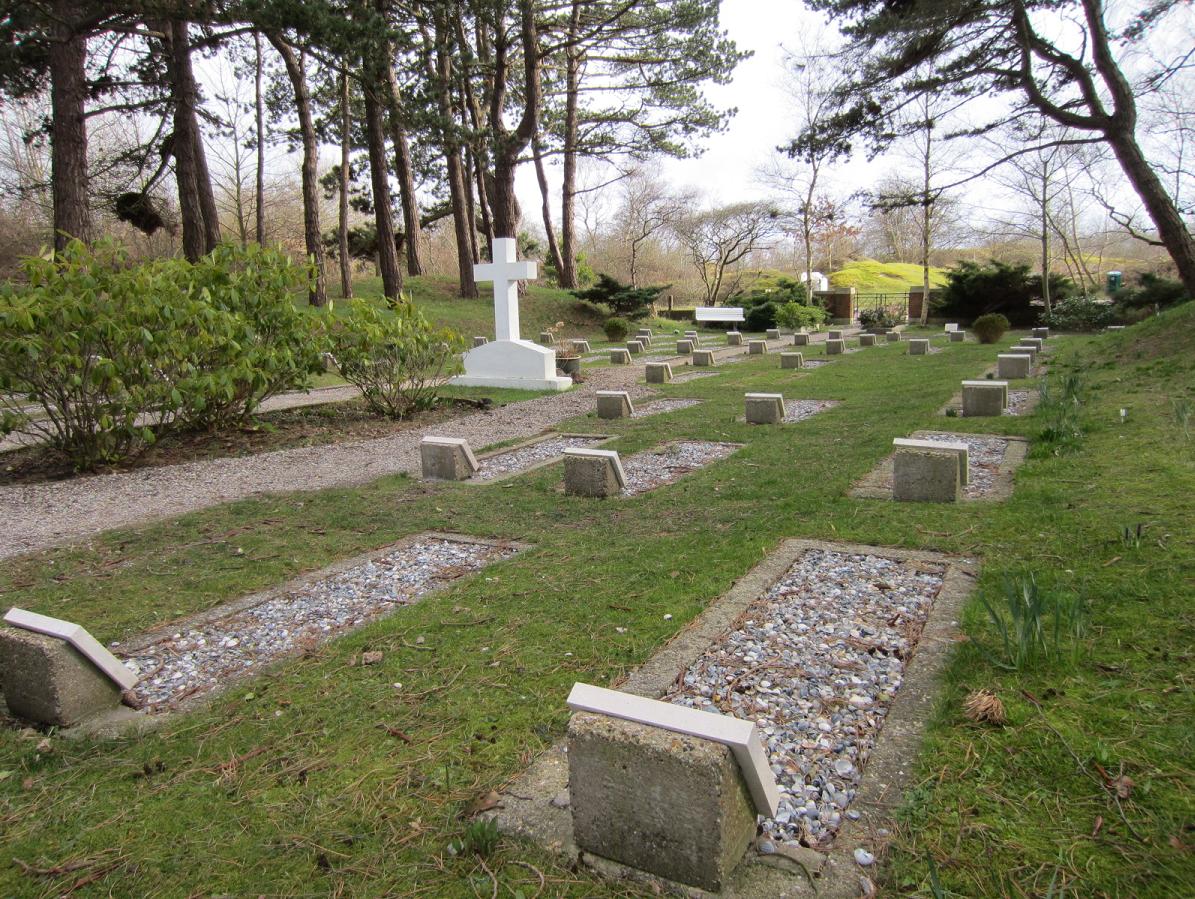
Plot 1. Exhumed French 1949, the English fisherman 1906
Below. Open spaces of the exhumed French are well visible today. Near the entrance and left of the bench is grave 1 of the elderly English fisherman 1906. His grave was a field grave in the dunes and already here before the cemetery was build in 1917. Grave 1 is facing north. In 1917 it was decided to face the new graves south.
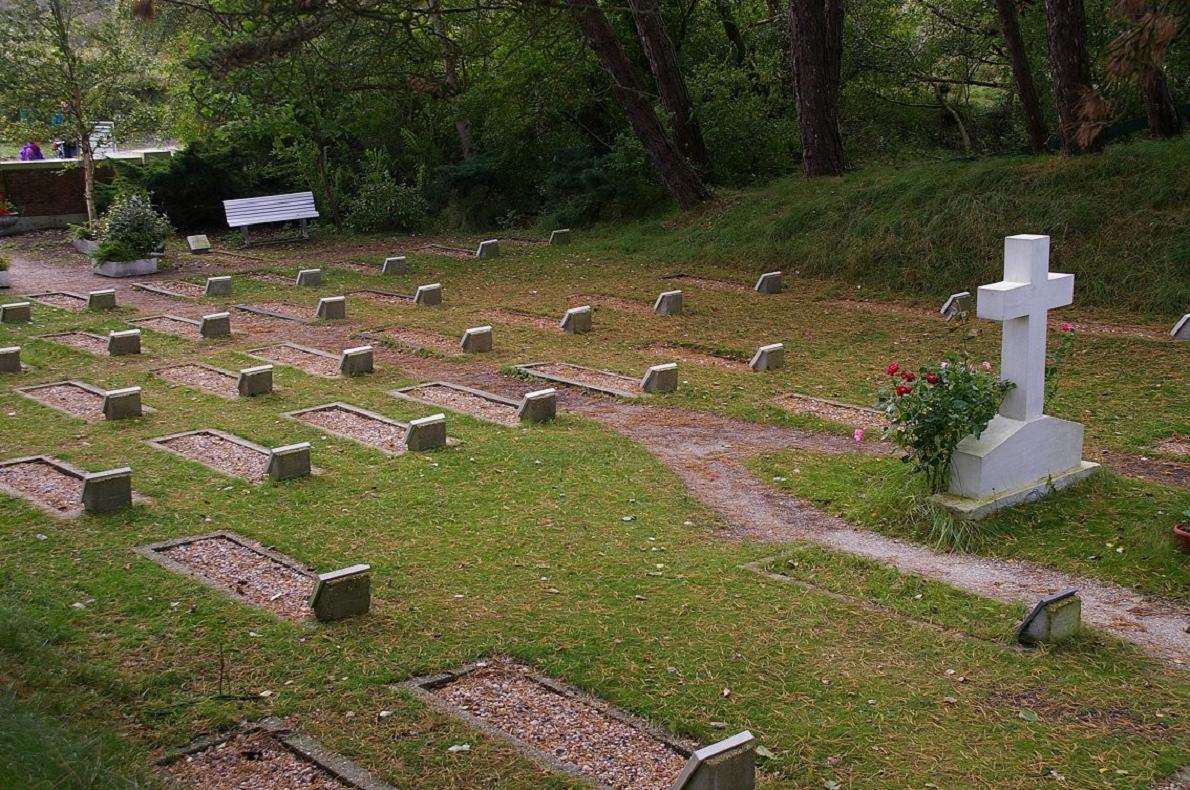
Plot 2
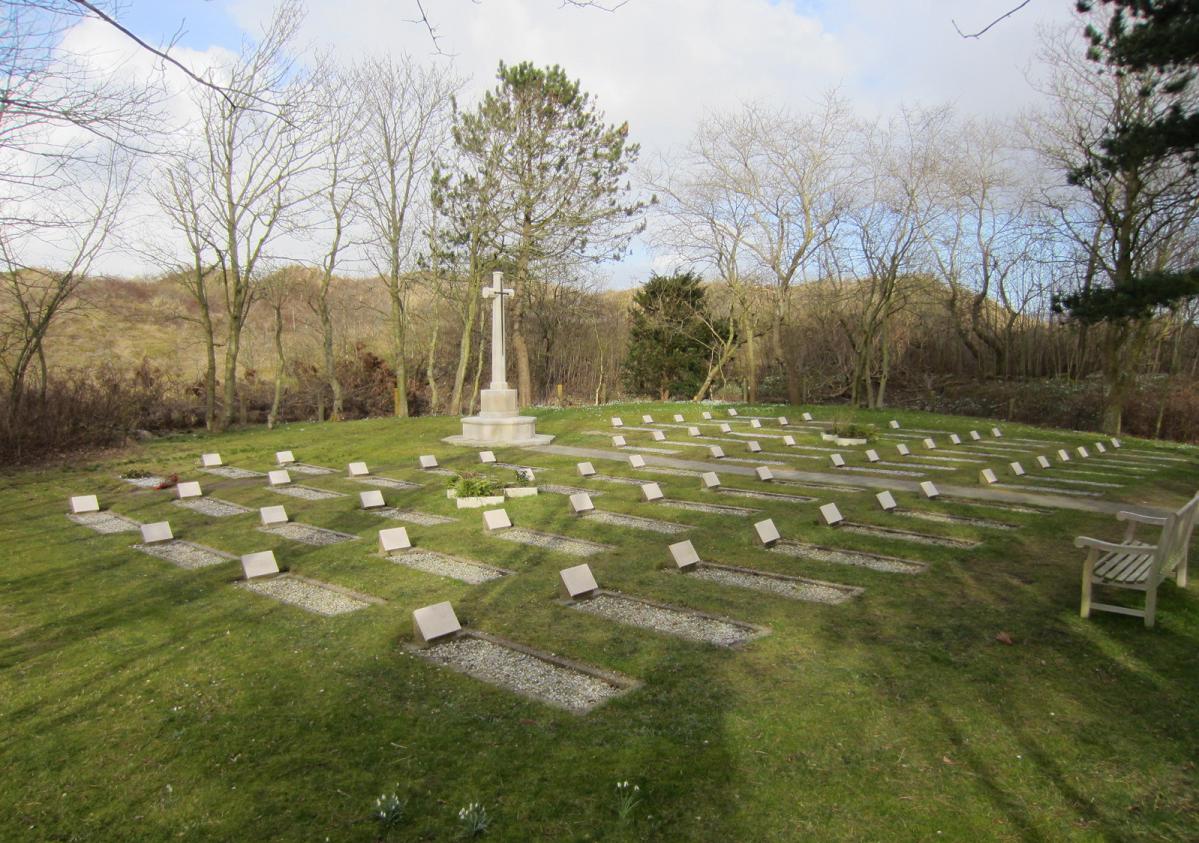
.
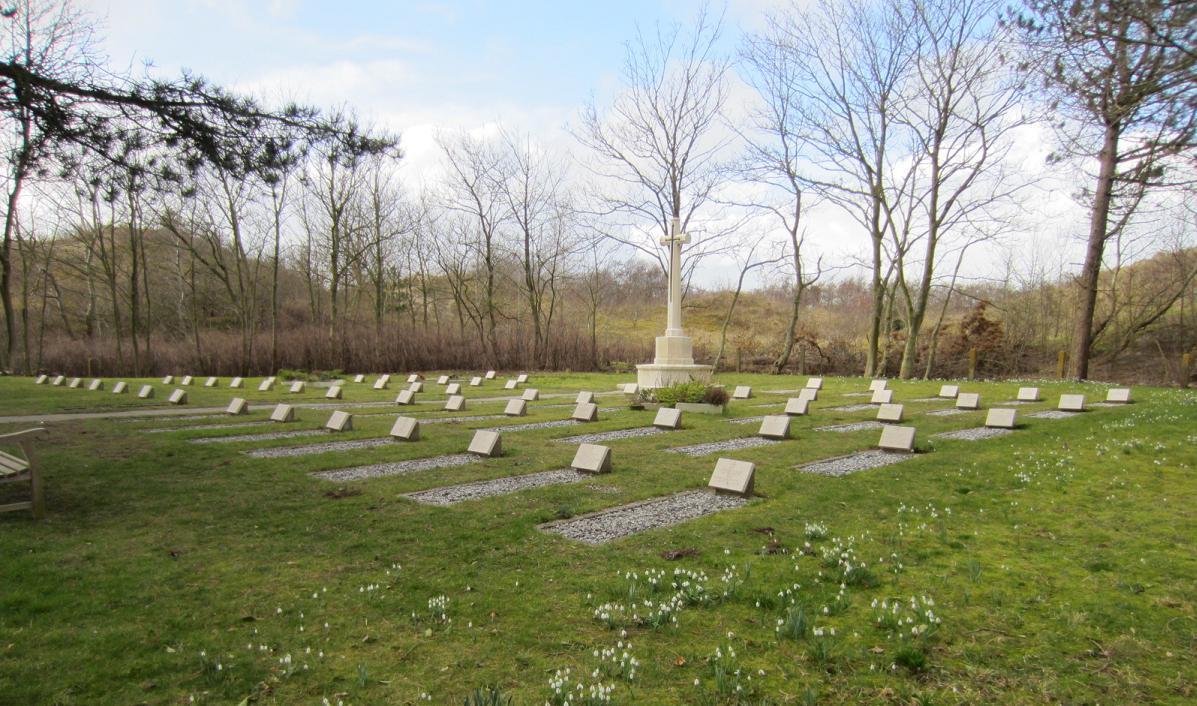
.
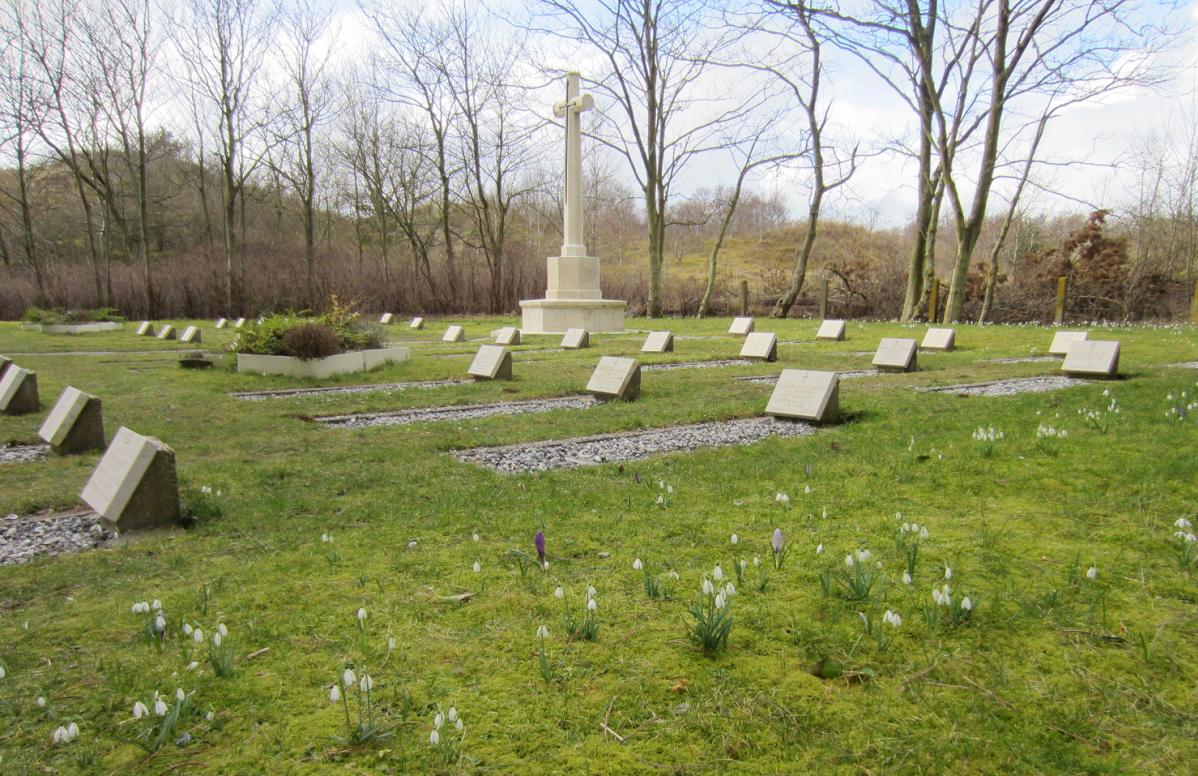
.
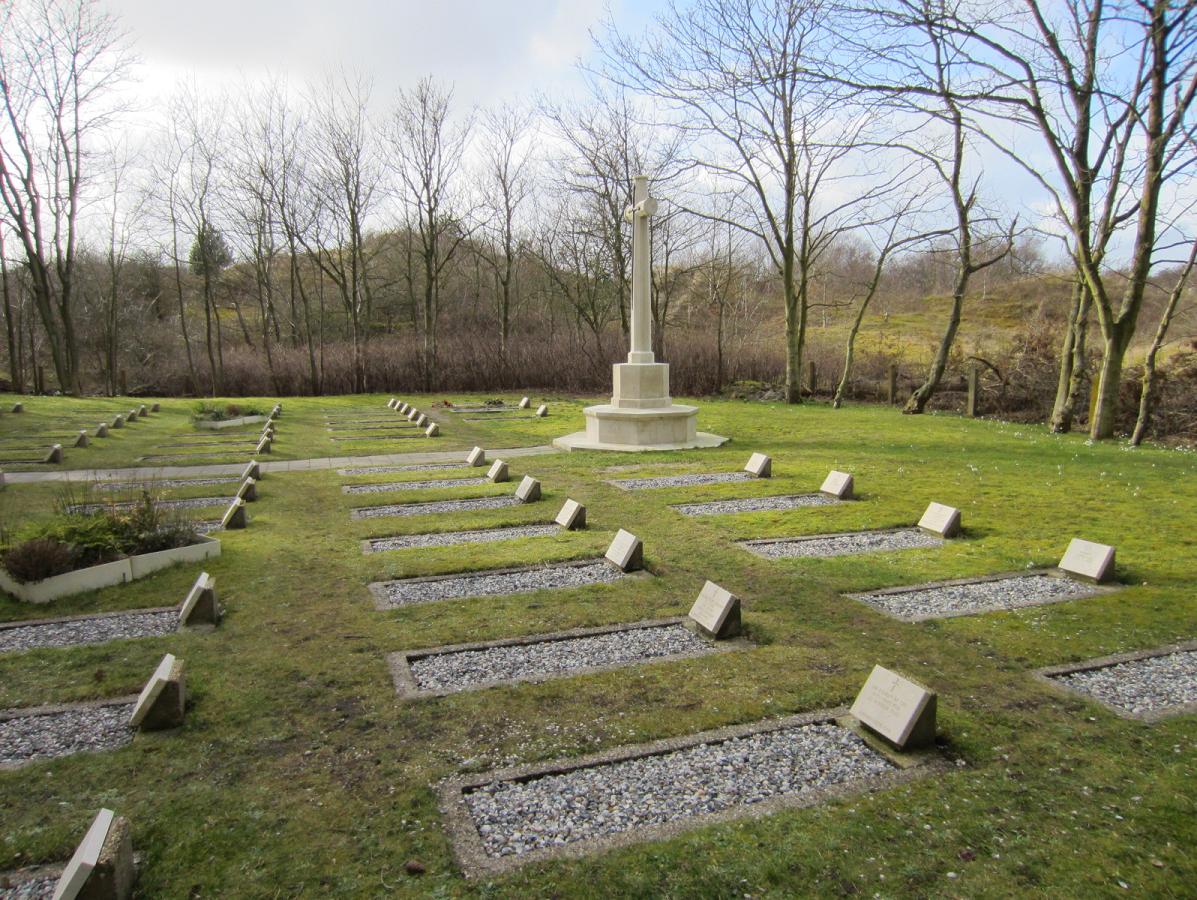
.
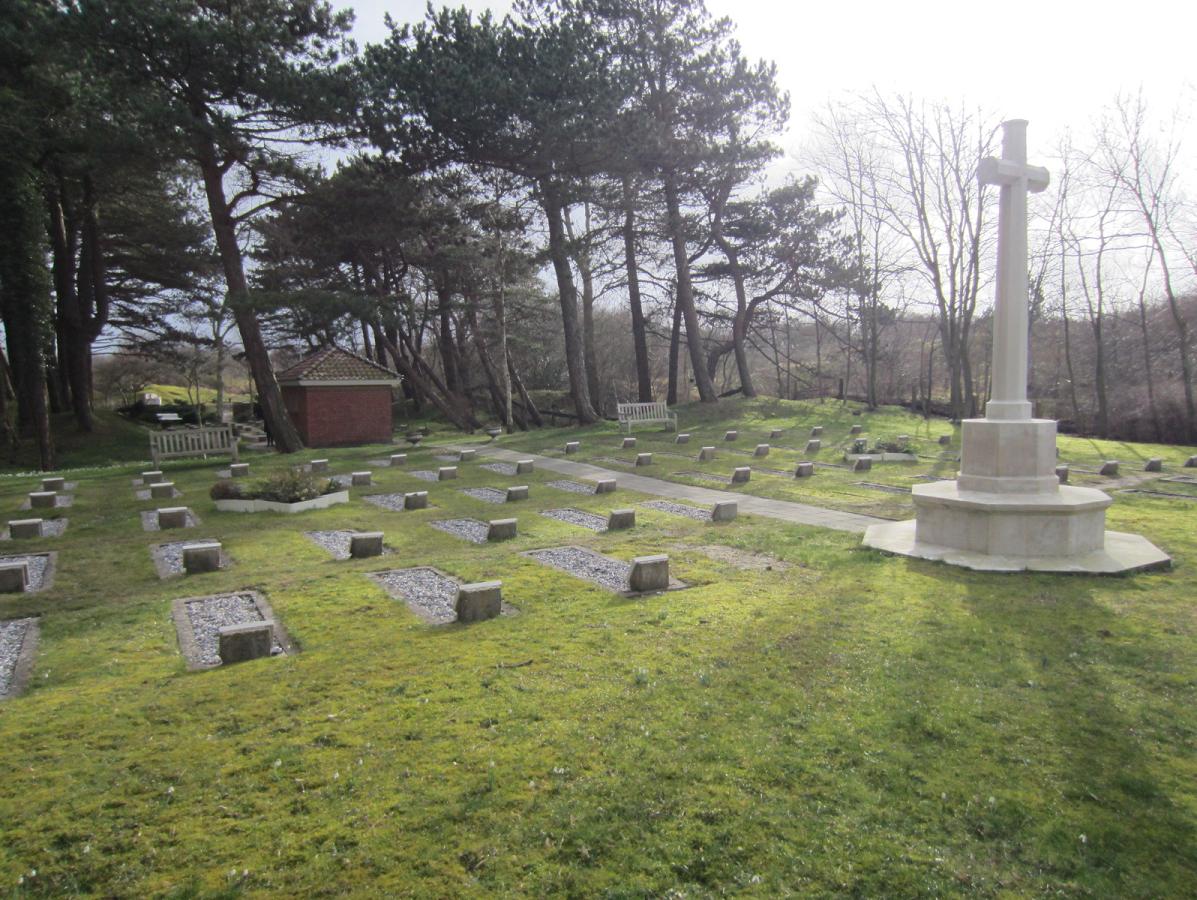
------------
Below. The fresh grave of Mr. Jan Fischer, next to the graves of Mr. Sake van der Werff and his son.
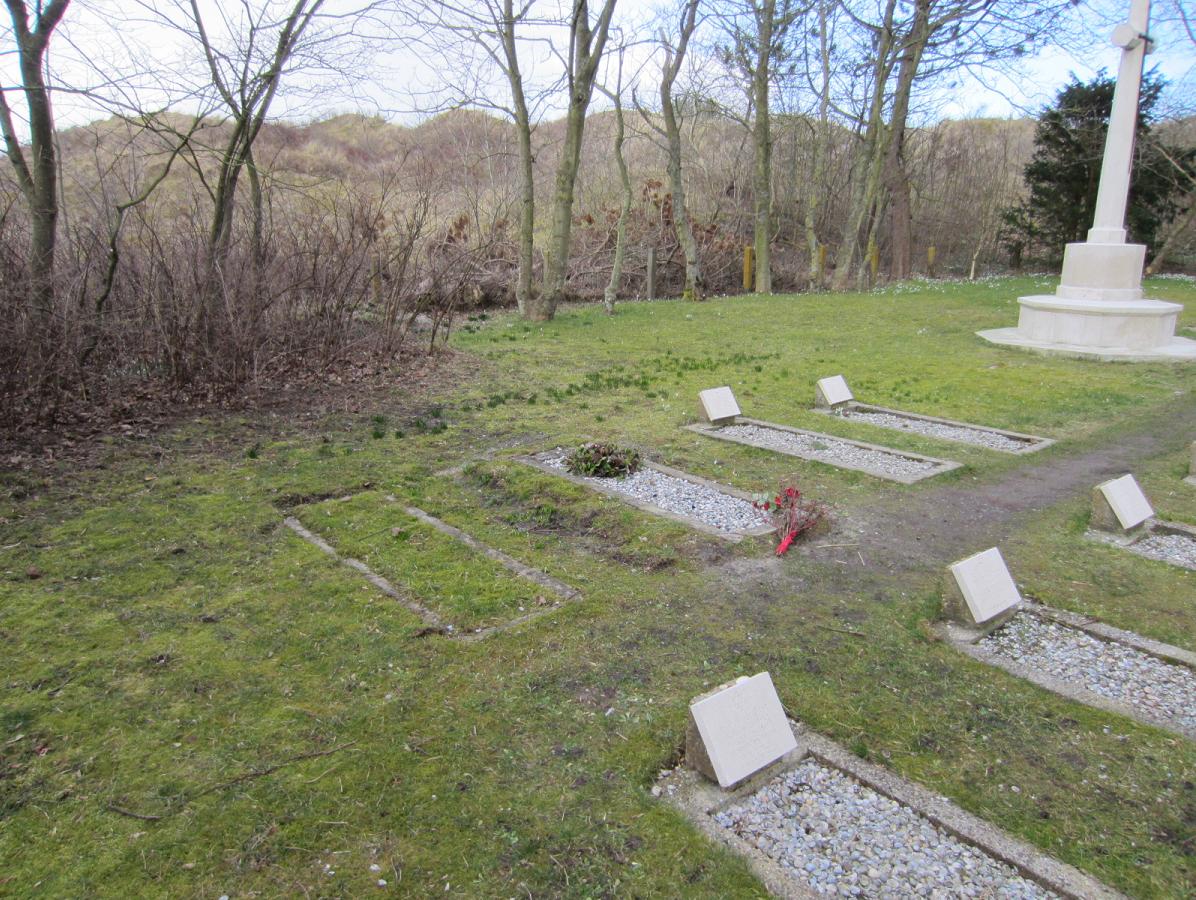
CEMETERY STATISTICS
Buried on Vredenhof today are in total 113 persons:
- 47 Commonwealth servicemen, with name, most airmen, WW2:
See for their names website CWGC https://www.cwgc.org/find-a-cemetery/cemetery/2062402 .
- 7 French soldiers and sailors (1940, Dunkirk), identified (including Fernand Lafosse).
- 2 Polish airman, identified, 1942.
- 4 German soldiers, identified, WW2.
- 17 men 1906-1938 (1 English fisherman 1906, 1 English Royal Navy sailor 1918, 3 German sailors 1921-1938, 12 German Navy Sailors 1917-1918).
- 3 Dutch civilians, with name, 1955 (Van der Werff) and 2014 (Jan Fischer)
Non-identified: in total 33 men, known unto God, WW2. There are:
- 4 unknown Merchant navy sailors
- 11 unknown Commonwealth airmen
- 1 unknown Polish airman, not identified
- 1 unknown airman, possible English or French (grave 47)
- 14 French soldiers and sailors (inconnu, Mort pour la France).
- 2 unknown persons, 1959 and 1968 (one identified as Mr. Albert Zwaan August 2015)
Sources:
- Newspaper articles
- Postcard collection ZZAW
- Booklet 'oorlogsgraven Vredenhof' exposition 1998.
- Site CWGC
- Website MémorialGenWeb
- Special thanks to Wyb-Jan Groendijk and Hotel Van der Werff
- René Hoebeke.
© ZZairwar (Zuyder Zee Air War).